

Cecil County Community Health Needs Assessment
May 7, 2025


EXECUTIVE SUMMARY
Introduction
This Community Health Needs Assessment (CHNA) was conducted by ChristianaCare Union Hospital in collaboration with the Cecil County Health Department and the Cecil County Community Health Advisory Committee (CHAC) to identify significant community health needs and to inform development of an Implementation Strategy to address current needs. These organizations collaborated through gathering and assessing secondary data; conducting community meetings, focus groups, key stakeholder interviews, and a community health survey; and relying on shared methodologies, report formats, and staff to manage the CHNA process.
ChristianaCare Union Hospital (Union Hospital or the hospital) is a 72-bed, full-service community hospital located in downtown Elkton, Maryland. Union Hospital provides an assortment of specialty care services, including oncology, gastroenterology, and imaging and laboratory services. Additional information about Union Hospital is available at: https://www.uhcc.com/
Union Hospital is part of the ChristianaCare Health System (ChristianaCare). ChristianaCare is comprised of three hospitals (1,200 beds total) and a variety of outpatient and other services. The primary campuses are in Wilmington and Newark, Delaware and in Elkton, Maryland. Additional information on Christiana Care Health System and its three hospital facilities can be found at: https://christianacare.org/about/.
The Cecil County Health Department works to promote, protect, and advance the health and wellness of Cecil County, Maryland. The department offers services to all county residents through six divisions: Administrative Services, Behavioral Health Services, Community Health Services, Environmental Health Services, Health Promotion, and Special Populations Services. The department’s responsibilities include preventing epidemics and the spread of disease, protecting against environmental hazards, preventing injury, promoting and encouraging healthy behavior and mental health, responding to disasters and assisting communities in recovery, and assuring the quality and accessibility of health services.
CHAC is a partnership of community organizations, government, groups, and individuals committed to improve the overall quality of health in Cecil County. CHAC serves as Cecil County’s Local Health Improvement Coalition (LHIC) and works closely with several task forces and councils including Cancer Task Force, Tobacco Task Force, Behavioral Health Advisory Council, and Healthy Lifestyles Task Force.
This CHNA has been conducted using widely accepted methodologies to identify the significant health needs of Cecil County, Maryland. The assessment also has been conducted to comply with federal and state laws and regulations.
Community Assessed
For purposes of this CHNA, the community is defined as Cecil County, Maryland. During the year ended June 30, 2023, Cecil County accounted for approximately 82 percent of the hospital’s total inpatient volumes and 81 percent of total emergency department visits.
The total population of Cecil County in 2022 was approximately 103,900 people.
The following map portrays the community assessed by Union Hospital and the location of its main campus.
Map of Cecil County, ChristianaCare Union Hospital Community
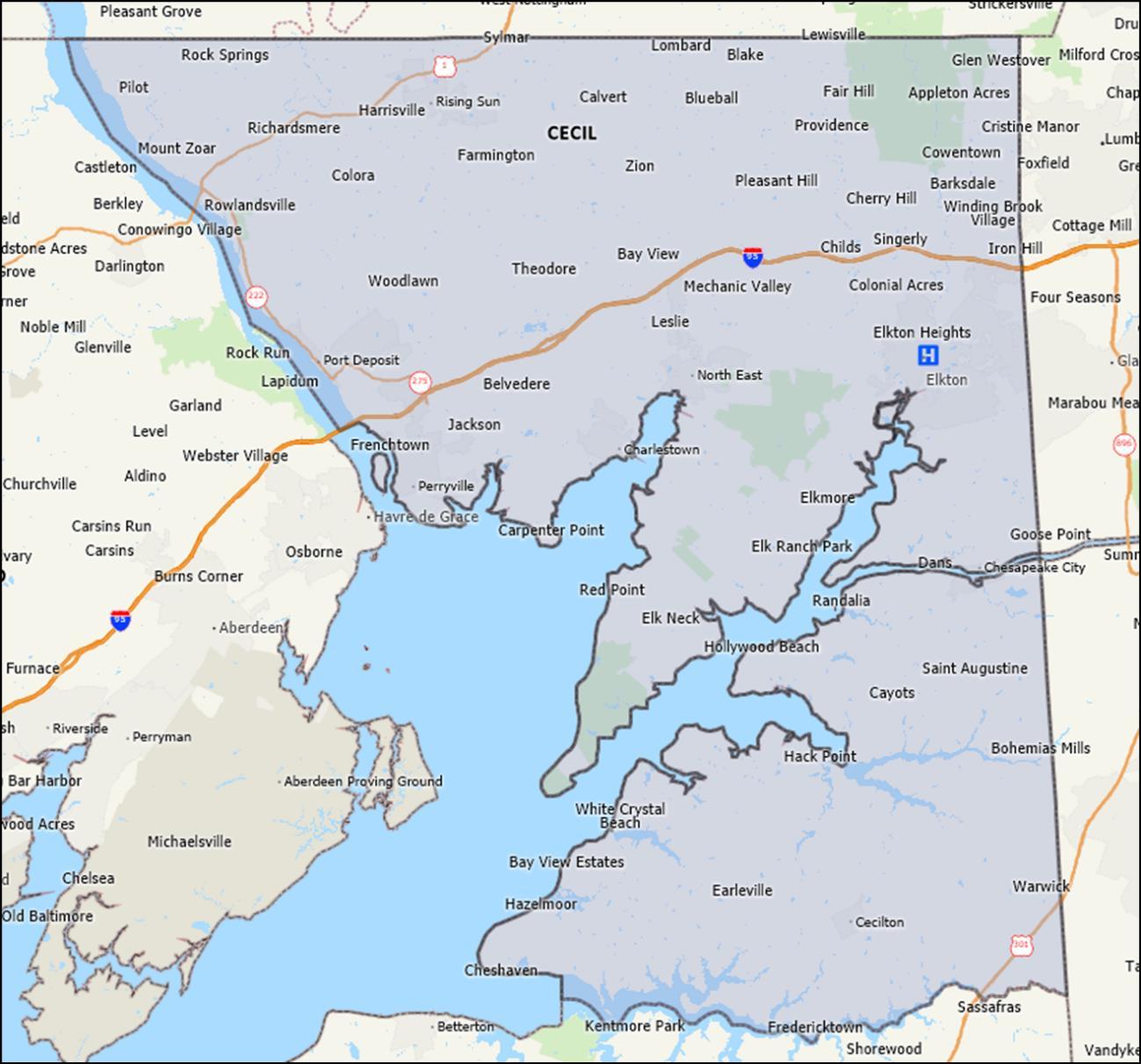
Source: Caliper Maptitude, 2024.
Significant Community Health Needs
As determined by analyses of quantitative and qualitative data, and prioritization by partners and stakeholders representing the broad interests of the community and including individuals with special knowledge of or expertise in public health, the significant health needs in the community served by ChristianaCare Union Hospital are:
• Access to Health and Preventive Services
• Cancer
• Childhood Trauma & Adverse Childhood Experiences (ACEs)
• LGBTQ+ Health Disparities
• Maternal and Child Health
• Mental Health
• Nutrition, Physical Activity, and Chronic Conditions
• Social Determinants of Health
• Smoking, Tobacco, and Vape Product Use
• Substance Use Disorders
• Violence and Injury
Significant Community Health Needs: Discussion
Access to Health and Preventive Services
Accessing health and preventive services is challenging for some members of the community, particularly residents who are uninsured or underinsured, have limited financial resources, have limited English proficiency, are living with a disability, and who are members of racial, ethnic, and other minority groups
Secondary data indicate access to health and preventive services as a significant community health need, including the following:
• Length of life, or years of potential life lost before age 75, ranked in the bottom quartile of peer counties.
• Preventable hospitalizations for Medicare enrollees ranked in the bottom half of peer counties.
• The per capita supply of primary care physicians, mental health providers, and dentists was significantly lower in Cecil County, compared to Maryland and the U.S.
• An anticipated growth of 43.5 percent in the cohort aged 65 years and older between 2020-2030 will likely lead to an increased demand for health services.
• Utilization of preventive services, such as cervical cancer screening, colon cancer screening, mammogram, core preventive services in women, compliance with blood pressure medication, and routine checkup, was lower than U.S. averages in many Cecil County ZIP Codes.
• “Physical health not good for 14 days or more” compared unfavorably in many Cecil County ZIP Codes to U.S. averages.
• Federal designation of the county as a primary care Health Professional Shortage Area (HPSA) for the Medicaid Eligible Population.
• Federal designation of Cecil County as mental health HPSA.
• Federal designation of census tracts in Conowingo and Perryville as Medically Underserved Areas (MUAs).
• The Cecil County Community Health Improvement Plan (2023-2027) and the 2024 Maryland State Health Improvement Plan (SHIP) identified access to health services as a priority.
Community input confirmed access to health and preventive services as a significant need. Over 60 percent of the community survey respondents identified the availability of doctors or other providers and appointments as a significant barrier to accessing health services. The primary care shortage is a critical issue, and some specialty care is limited including OB/GYN and women’s health care, oncology and cancer treatment, cardiology, children’s healthcare services, rheumatology, dermatology, and others. Healthcare workforce shortages are cited as a significant and growing concern. Other access barriers include cost of care (despite insurance), insurance restrictions and limitations, coordination of care, language barriers, and navigation challenges. Residents are challenged to find local providers (doctors and dentists) who accept insurance plans, especially Medicaid, leading to long wait-times and worsening health problems. Licensure issues and nontransferability of Medicaid across Maryland - Delaware state lines worsen access barriers. There is a need for improved cultural sensitivity, language and translation services, especially more educational programs and materials offered in Spanish.
Cancer
Cancer mortality rates in Cecil County have been above Maryland and U.S. averages and utilization of cancer screening tests have been below U.S. averages.
Secondary data indicate cancer as a significant community health need, including the following:
• Utilization of cancer screening and detection methods including colon cancer tests and mammograms were below U.S. averages in every Cecil County ZIP Code.
• Cervical cancer screening rates were below U.S. averages in most Cecil County ZIP Codes.
• Between 2015-2020, Cecil County overall cancer mortality rates (age-adjusted, per 100,000 population) were higher than Maryland and U.S. averages (181.0, 149.7, and 150.8).
• Cecil County mortality rates for bronchus or lung, bladder, esophagus, and liver cancers were more than 50 percent above U.S. averages.
• The Cecil County Community Health Improvement Plan (2023-2027) and the 2024 Maryland State Health Improvement Plan (SHIP) prioritized access to cancer screening services.
Community input indicates cancer as a significant community health concern, particularly related to the high prevalence of cancer, low utilization of cancer screening tests, and prevalence of contributing lifestyle factors such as smoking, unhealthy diets, alcohol use, and lack of exercise. Community members also express concern with the limited availability of oncology and cancer treatment services and barriers to accessing care outside the community.
Childhood Trauma & Adverse Childhood Experiences (ACEs)
Adverse childhood experiences (ACEs) can have long-term negative impacts on health, opportunity, and well-being. The Centers for Disease Control and Prevention defines ACEs as potentially traumatic events that occur in childhood (0-17 years), including experiencing violence, abuse, or neglect, witnessing violence in the home, and/or having a family member attempt or die by suicide. ACEs also can include other aspects of the child’s environment that undermine a sense of safety, such as substance use or mental health problems in the home, or instability due to parental separation or a household member being in jail or prison.1
Secondary data indicate childhood trauma and ACEs as a significant community health need, including the following:
• A comparatively high percentage of Cecil County adults (27.8 percent) have reported 3-8 ACEs during childhood – above the averages in Maryland (23.3 percent) and the U.S. (17.3 percent).2
• The 2023-2027 Cecil County Community Health Improvement Plan identified childhood trauma as a primary area to be addressed under the priority area of mental health.
Community input emphasized concerns related to the high prevalence of ACEs. The impacts of generational trauma, often related to substance use and mental health issues, are concerning and complicate interventions and treatment. Community survey respondents identified child abuse and neglect, childhood trauma, and other contributing factors such as substance abuse and mental health as top community health concerns.
LGBTQ+ Health Disparities
Research suggests that LGBTQ+ individuals face health inequities due to social stigma, discrimination, and denial of civil rights. Discrimination has been linked to high rates of psychiatric disorders, substance use, and suicide. Experiences of violence and victimization are common for LGBTQ+ individuals. Mental health and personal safety are often compromised by lack of family and social acceptance of sexual orientation and/or gender identity.3
Secondary data indicate LGBTQ+ health disparities as a significant community health need, including the following:
• Maryland residents who identified as LGBT were more likely to be unemployed, food insecure, and have low-income than those who identified as non-LGBT in the state and nationally.
1 https://www.cdc.gov/aces/about/index.html
2 U.S. average is for four or more ACEs (Behavioral Risk Factor Surveillance System ACE Data |Violence Prevention|Injury Center|CDC)
3 https://www.healthypeople.gov/2020/topics-objectives/topic/lesbian-gay-bisexual-andtransgender-health
• Cecil County youth who identified as gay, lesbian, or bisexual were two to three times as likely to be electronically bullied, bullied on school property, to feel sad or hopeless most days for more than two weeks in a row, and to seriously attempt suicide compared to youth who identified as straight or heterosexual.
Community input participants express that Cecil County is a “tough place to be queer” and note a need to create a sense of security, safety, and acceptance for the LGBTQ+ community. The LGBTQ+ community was frequently mentioned as a population with unmet social and medical needs.
Maternal and Child Health
Maternal and child health were identified as significant community health concerns and as disproportionately impacting racial and ethnic minority populations and residents with limited financial resources.
Secondary data indicate maternal and child health as significant needs in Cecil County, including the following:
• The proportion of children living in poverty in Cecil County (13.7 percent) was above the proportion in Maryland (11.8 percent).
• Low birthweight births for non-Hispanic Black residents were significantly higher in Cecil County and Maryland compared to rates for non-Hispanic White residents.
• The overall rate of teen mothers giving birth was higher in Cecil County compared to state and national averages.
• Rates for non-Hispanic Black and Hispanic (or Latino) teen mothers giving birth were twice the rate of non-Hispanic White teen mothers in Cecil County.
• Infant mortality rates for non-Hispanic Black and Hispanic (or Latino) populations have been significantly higher than rates for non-Hispanic White populations in Maryland compared to U.S. averages.
• The 2024 Maryland State Health Improvement Plan (SHIP) prioritized women’s health including maternal health outcomes.
Community members providing input into this CHNA identified problems with access to care for women’s health and a critical shortage of OB/GYN providers. Participants cited maternal and infant mortality, especially amongst Black and Hispanic populations, births to teen mothers, and an undersupply of pediatric services as significant concerns.
Mental Health
Mental health status is poor for many community members and the supply of mental health providers and services is insufficient to meet the demand.
Secondary data indicate mental health is a significant need in Cecil County, including the following:
• Cecil County (5.5 days) and Maryland (5.2 days) compared unfavorably to the United States (4.8 days) for prevalence of mentally unhealthy days among adults.
• The percentage of adults reporting “mental health not good for 14 or more days” was above U.S. averages in most Cecil County ZIP Codes.
• Depression rates were higher in most Cecil County ZIP Codes compared to U.S. averages.
• At 16.2 deaths per 100,000 population, the county’s suicide mortality rate was significantly higher than Maryland (10.2 per 100,000) and U.S. averages (14.5 per 100,000).
• Cecil County is federally designated a Health Professional Shortage Area (HPSA) for mental health.
• The number of social associations per 10,000 population was lower in Cecil County (7.0) and Maryland (8.8) compared to the United States (9.1).
• The Cecil County Community Health Improvement Plan (2023-2027) and the 2024 Maryland State Health Improvement Plan (SHIP) identified mental health as a priority.
Community input identified poor mental health status and access to mental health services as pressing community health needs. There is an undersupply of counselors, therapists, psychiatrists, and crisis team resources and a crucial need for mental health providers trained in child-based interventions, trauma-informed care, and developmental disabilities. Substance use disorders, mental health issues, and poor physical health are often intertwined and complicate treatment and recovery.
Nutrition, Physical Inactivity, and Chronic Conditions
Obesity, physical inactivity, and related chronic conditions are prevalent throughout Cecil County contributing to decreased quality of life and poor health outcomes.
Secondary data indicate nutrition, physical activity, and chronic conditions as significant health needs in Cecil County, including the following:
• Adult obesity rates were higher in every Cecil County ZIP Code compared to U.S. averages.
• The percentage of residents with access to exercise opportunities was lower than overall Maryland and United States percentages.
• The percentage of adults reporting no leisure time physical activity was higher in Cecil County (25.4 percent) compared to Maryland (21.2 percent) and the U.S. (23.0 percent).
• Mortality rates for chronic conditions associated with obesity, such as heart disease and diabetes, were above U.S. rates.
• The prevalence of COPD, asthma, high blood pressure, and high cholesterol was higher in most Cecil County ZIP Codes compared to U.S. averages.
• The 2024 Maryland SHIP has prioritized enhancing primary prevention of chronic disease and screening, treatment, and care for chronic illness.
Community input participants confirmed nutrition, physical activity, and chronic conditions as significant health needs. Contributing factors were identified as negative impacts of the built environment, such as lack of parks and green spaces, decreased walkability, and cost and limited availability of quality grocery stores. Participants discussed a general decline in health and wellbeing post-COVID and a trend towards less healthy lifestyles from habits
established during isolation. Community input identified a need for increased nutrition education, community-based screenings, and an investment in health and wellness education in school-aged children and adolescents.
Social Determinants of Health
Social Determinants of Health (SDOH) are conditions in the environment where people are born, live, learn, work, play, worship, and age that affect a wide range of health, functioning, and quality-of-life outcomes and risks.4 Social determinants of health play an important role in health equity.
Secondary data indicate SDOH are a significant health need in Cecil County, including the following:
• Federally designated low-income census tracts and low-income and low access to healthy food census tracts were concentrated in Elkton (proximate to Union Hospital) and Port Deposit.
• There was a high prevalence of food insecurity amongst Black residents (16.0 percent) compared to the overall food insecurity rate (9.7 percent) and the rate for White residents (5.0 percent) in Cecil County.
• The percentage of households in Cecil County designated as “rent burdened” (spending more than 30 percent of income on housing) was higher than state and national averages; and ZIP Codes in Perry Point5, Port Deposit, Charlestown, Conowingo, and Elkton had over 50 percent of households rent burdened.
• The Area Deprivation Index ranked neighborhoods in Elkton, Perry Point, Perryville, Port Deposit, and North East as having high levels of socioeconomic disadvantage.
• The CDC’s Heat and Health Index indicated ZIP Codes in North East, Perry Point, and Perryville had the highest levels of risk for negative outcomes due to heat.
Community input participants identified SDOH as significant needs adversely impacting health, including poverty, income inequality, food insecurity, safe and affordable housing, access to transportation, education, employment, and childcare. Access to safe and affordable housing is a crucial issue. Strict qualification requirements, high cost, and long waitlists prevent some residents from establishing stable housing. Participants express there has been an inadequate response to the rise in homelessness. Limited options for quality, reliable, and affordable childcare impact some resident’s ability to secure adequate employment and to access healthcare, disproportionately impacting young women and single parent households. Limited transportation is an access barrier, especially for residents living in rural areas, those without a private vehicle, and limited financial resources.
Smoking, Tobacco, and Vape Product Use
Smoking, tobacco, and vape product use are prevalent throughout Cecil County and contribute to poor health outcomes.
4 https://health.gov/healthypeople/priority-areas/social-determinants-health
5 Perry Point is home to The Veterans Independence Project (VIP) and provides immediate housing and supportive services to homeless veterans (https://chepinc.org/veteran-housing).
Secondary data indicate smoking, tobacco, and vape product use are significant health needs in Cecil County, including the following:
• Adult smoking rates have been higher in Cecil County (18.1 percent) than in Maryland (10.2 percent) and the U.S. (15.0 percent).
• Bronchus or lung cancer mortality rates were significantly higher in Cecil County (57.2 per 100,000 population) than in Maryland (33.8 per 100,000) and the U.S. (35.1 per 100,000).
• Rates of Chronic Obstructive Pulmonary Disease (COPD) were higher in most Cecil County ZIP Codes compared to U.S. averages.
• The rate of Cecil County youth reporting current smoking was more than 50 percent above Maryland and U.S. rates.
Community input confirmed smoking, tobacco, and vaping as top concerns. High smoking rates have been problematic, and participants note an increase in vaping, especially amongst youth and adolescents. The “normalization” of vaping and perceptions of it being healthier than smoking are concerning.
Substance Use Disorders
Substance use is a widespread issue, affecting all ages and demographics.
. Secondary data indicates substance use disorders as a significant need in Cecil County, including the following:
• Cecil County (81.7 per 100,000) and Maryland (43.4 per 100,000) had significantly higher average rates of poisoning mortality (including drug overdose) compared to U.S. rates (28.5 per 100,000).
• Poisoning mortality rates were significantly higher in male populations (112.3 per 100,000) in Cecil County and Maryland (63.9 per 100,000) compared to female populations (51.4 in Cecil County and 24.1 in Maryland).
• Binge drinking was higher in most Cecil County ZIP Codes compared to national averages.
• The percentage of Cecil County youth reporting binge drinking (11.9 percent) was above state (9.8 percent) and national averages (10.5 percent).
• The Cecil County Community Health Improvement Plan (2023-2027) and the 2024 Maryland State Health Improvement Plan (SHIP) prioritized substance use disorders.
Community input identified substance use as a top community concern. Participants express that substance use is a widespread issue, affecting all ages and demographics, with concerns related to alcohol, opioids, marijuana use, and fatal and non-fatal overdoses. Trauma and generational impacts on children with early exposure to drug and alcohol misuse are notable and often lead to cycles of substance use and mental health concerns. The Cecil County opioid crisis is described as an “urban problem with rural resources” making it especially difficult to combat. There is a need for prevention, recovery support services, and improved treatment options, especially for the interrelationship of substance use disorder and mental health issues.
Violence and Injury
Community safety, injury, and violence impacts community members’ physical and mental health, their ability to engage in daily activities, can result in death, and have long-term effects on individuals and families.
Secondary data indicate violence and injury as a significant health need in Cecil County, including the following:
• Injury mortality was significantly higher in Cecil County (134.9 per 100,000) compared to Maryland (91.8 per 100,000) the U.S. (80.0 per 100,000).
• Disability rates were higher in numerous community ZIP Codes compared to the U.S.
• The percentages of Cecil County youth reporting electronic bullying and being bullied on school property were well above Maryland and U.S. averages.
• At 13.8 percent, Cecil County youth experiencing physical dating violence was more than 50 percent above the U.S. average (8.5 percent).
Community input indicated a rise in violence as a significant health concern, especially amongst youth and teens. Participants expressed that children and youth have decreased ability to self-regulate emotions, leading to anger and violence. Physical violence has become an issue in some public spaces where young people congregate. Community members also note a rise in violence associated with an increase in the unhoused population.
DATA AND ANALYSIS
Community Definition
This section identifies the community that was assessed by Union Hospital. The community was defined by considering the geographic origins of the hospital’s discharges and emergency room visits during the year ended June 30, 2023.
On that basis, Union Hospital’s community was defined as Cecil County. The county accounted for approximately 82 percent of the hospital’s 2023 inpatient volumes and 81 percent of its emergency room visits (Exhibit 1).
Exhibit 1: Union Hospital Discharges and Emergency Room Visits, 2023
Source: Analysis of Union Hospital’s utilization data, 2023.
The total population of Cecil County in 2022 was approximately 103,900 people (Exhibit 2).
Exhibit 2: Community Population by ZIP Code
Source: U.S. Census, ACS 5-Year Estimates, 2018-2022.
The hospital is in Elkton, Maryland (Cecil County ZIP Code 21921). Exhibit 3 portrays the community and ZIP Code boundaries within Cecil County.
Exhibit 3: Union Hospital Community
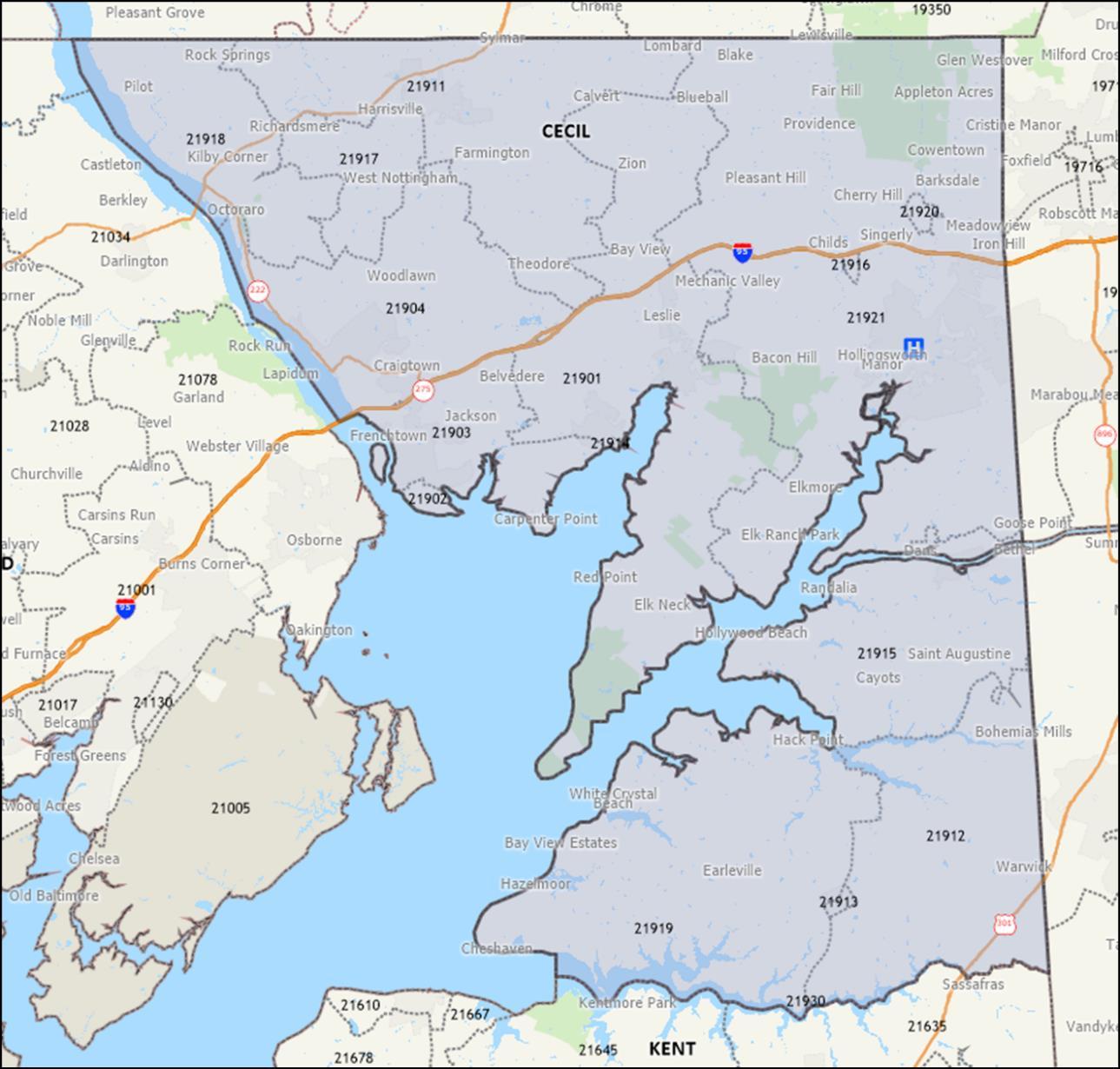
Source: Caliper Maptitude, 2024.
Secondary Data Summary
The following section summarizes principal observations from the secondary data analysis. See Appendix B for more detailed information.
Demographics
Demographic characteristics and trends directly influence community health needs. The total population of Cecil County in 2022 was approximately 103,900 people. Cecil County’s population is expected to increase 8.7 percent between 2020 and 2030, representing an increase of approximately 9,000 people. Among four age cohorts (0-19, 20-44, 45-64, and 65 and older), the aged 65 and older cohort is anticipated to have the fastest growth rate, 43.5 percent between 2020-2030. This change will likely contribute
to greater demand for health services as older adults tend to utilize more services than younger people.
Demographic characteristics, such as age, race, ethnicity, education, and income levels, vary across the county.
Over 30 percent of residents in ZIP Codes 21902 (Perry Point), 21914 (Charlestown), and 21912 (Warwick) were age 65 or older in 2018-2022 while this proportion was approximately 11.0 percent in ZIP Code 21901 (North East).
Over 50.0 percent of residents in ZIP Code 21902 (Perry Point) identified as Black or African American while this proportion was 10 percent or below in all other Cecil County ZIP Codes.
At 16.2 percent, Elk Mills (ZIP Code 21920) had the highest share of the population identified as Hispanic (or Latino) while this share was under 10.0 percent in all other Cecil County ZIP Codes.
In 2018-2022, the percentage of residents aged 25 and older without a high school diploma in Cecil County and Maryland was below the national average. Cecil County had a higher percentage of population living with a disability than Maryland and the United States. Proportions of residents linguistically isolated was significantly lower in Cecil County compared to the Maryland and U.S. average.
Socioeconomic Indicators
Across the lifespan, people who live in impoverished communities have an increased risk for chronic diseases and illness, higher mortality, and lower life expectancy.6
In 2018-2022, 10.1 percent of Cecil County residents lived in poverty, higher than Maryland (9.3 percent) and lower than the U.S. averages (12.5 percent). Poverty rates for Black, Asian, and Hispanic (or Latino) residents have been well above rates for White residents (20.1, 18.2 and 10.9, compared to 8.3 percent), in Cecil County. The percentage of children in poverty was higher in Cecil County (13.7 percent) compared to Maryland (11.5 percent) and lower than the U.S. average (16.7 percent).
Census tracts in Elkton and Port Deposit have been federally identified as low-income.
Disparities in socioeconomic indicators exist for lesbian, gay, bisexual, and transgender (LGBT) communities compared to non-LGBT communities in Maryland and the U.S. In 2019, Maryland and U.S. residents who identified as LGBT were more likely to be unemployed, uninsured, food insecure, and have low-income than those who identified as non-LGBT.
Census tracts federally designated as low-income and low access to healthy and affordable food were present in Elkton and Port Deposit. In 2021, the overall food insecurity rates in Cecil County and Maryland were lower than the national average for all
6 www.odphp.health.gov/healthypeople.
people; however, food insecurity rates for Black and Hispanic (or Latino) residents were comparatively higher.
From 2019-2023, unemployment rates for Cecil County and Maryland have been lower than national rates.
In 2018-2022, the county had a lower percentage (3.9 percent) of the population without health insurance than Maryland (5.9 percent) and the United States (8.7 percent).
In 2022, crime rates in Cecil County were lower than statewide and U.S. rates for all crime types. Crime rates for violent crime, murder, and robbery were higher in Maryland compared to national averages.
In 2018-2022, the percentage of households designated as rent burdened in Cecil County has been above state and national averages. In two ZIP Codes 21902 (Perry Point) and 21914 (Charlestown) the percentage of households designated as rent burdened was over 70 percent; and in Conowingo, Elkton, and Port Deposit (21918, 21921, and 21904) this share was over 50 percent.
The Area Deprivation Index, published by the University of Wisconsin, School of Medicine and Public Health, identified neighborhoods in Elkton, Perry Point, Perryville, Port Deposit, and North East as having high levels of socioeconomic disadvantage, including factors for income, education, employment, and housing quality.
Census tracts with the highest socioeconomic vulnerability were present in Elkton and North East according to the Centers for Disease Control’s Social Vulnerability Index.
In 2018-2022, the CDC’s Heat and Health Index scored ZIP Codes 21901 (North East), 21902 (Perry Point), and 21903 (Perryville) with the highest risk for negative outcomes due to heat in Cecil County.
Other Local Health Status and Access Indicators
In the 2024 County Health Rankings, Cecil County was assessed as faring worse than the average county in Maryland for Health Outcomes and Health Factors, and better than the average county in the nation for both. Cecil County compared unfavorably to the United States for 18 of the 33 County Health Rankings indicators. Cecil County compared significantly worse for the per capita supply of dentists and primary care physicians.
Community Health Status Indicators (CHSI) compares indicators for each county with those for peer counties across the United States. Each county is compared to 30 to 35 of its peers, which are selected based on socioeconomic characteristics such as population size, population density, percent elderly, per-capita income, and poverty rates.
In CHSI, Cecil County ranked in the bottom quartile of peer counties for numerous indicators, including:
• Years of potential life lost before age 75 per 100,000 population
• Average number of mentally unhealthy days
• Percent of live births with low birthweight
• Healthy food environment index
• Percent of female Medicare enrollees with mammography screening
• Income equality ratio
• Number of social associations per 10,000 population
• Injury mortality per 100,000 population
• Severe housing problems
Other secondary data from the Maryland Department of Health, CDC, Health Resources and Services Administration, and the United States Department of Agriculture, have been assessed. Based on an assessment of the available secondary data, the indicators presented in Exhibit 4 appear to be the most significant in Cecil County.
An indicator is considered significant if it was found to vary materially from a benchmark statistic, such the average value for Maryland, for peer counties, or for the United States. For example, in 2015-2020 there were 57.2 deaths due to lung or bronchus cancer (per 100,000 population) in Cecil County; there were 35.1 lung or bronchus cancer deaths (per 100,000) in the U.S.
Exhibit 4: Significant Indicators
When available Cecil County community health data are arrayed by race and ethnicity, significant differences are observed, for:
• Poverty rates
• Food insecurity rates
• Low birthweight babies
• Teen birth rates
These differences indicate the presence of racial and ethnic health inequities and disparities.
Medically Underserved Areas and Populations
Medically Underserved Areas and Populations (MUA/Ps) are designated by the Health Resources and Services Administration based on an “Index of Medical Underservice.” Conowingo and Perryville contain census tracts designated as medically underserved.
Health Professional Shortage Areas
A geographic area can receive a federal Health Professional Shortage Area (HPSA) designation if a shortage of primary medical care, dental care, or mental health care professionals is present.
• All of Cecil County has been designated a shortage area for mental health professionals.
• The Medicaid eligible population of Cecil County was designated as a HPSA for primary care.
• West Cecil Health Center, Mobile Medical Outreach Van, and Beacon Health Center were HPSA designated Federally Qualified Health Centers (FQHCs) for primary care, mental health, and dental health professionals.
Findings of Other CHNAs
Union Hospital and the Cecil County Health Department conducted a collaborative Community Health Assessment in 2022. The following list indicates issues identified as significant in that assessment (presented in alphabetical order):
• Access to health services
• Cancer
• Childhood trauma/Adverse Childhood Experiences (ACE)
• LGBTQ+ health disparities
• Mental health
• Nutrition, obesity, and physical inactivity
• Smoking, tobacco, and vape product use
• Substance use disorders
The 2024 Maryland State Health Improvement Plan identified chronic disease, access to care, women’s health, violence, and behavioral health as priority areas.
Community Input Summary
Community input was obtained through hospital and health department staff and community partner meetings, focus groups, key informant interviews, and a community health survey conducted between October 2024 and January 2025. A total of 95 individuals, from 22 organizations, participated in hospital and health department staff and community partner meetings, focus groups, and key informant interviews. These individuals represented the broad interests of the community and included people with special knowledge of or expertise in public health. Individuals included representatives from the Cecil County Health Department, Cecil County Health Advisory Committee (CHAC), hospital staff and providers, representatives of social service and non-profit organizations, and representatives of medically underserved, low-income, and minority populations. Community meetings and focus groups were conducted in-person October 28 to October 30, 2024. Interviews and a hospital and health department staff input meeting were conducted via online video conferences between November 2024 and January 2025. The Cecil County Health Department conducted an online community health survey between September and December 2024 with 540 responses received.
See Appendix C for a list of community input participant organizations and affiliations.
Hospital & Health Department Staff and Community Partner Meetings
A community partner meeting and a hospital and health department staff meeting were conducted to obtain input relevant to community health needs in Cecil County.
On October 28, 2024, sixteen (16) individuals, representing nine (9) organizations, participated in the community partner meeting These individuals represented non-profit organizations, social service organizations, local businesses, and health clinics. On November 20, 2024, twenty-four (24) staff members from Union Hospital and the Cecil County Health Department provided input. Participants represented a variety of roles and disciplines including administration, program coordinators, community engagement, nursing, acute care connectors, social workers, emergency care, and patient care coordinators.
Each meeting began with a presentation that discussed the CHNA process and purpose, an overview of secondary data, and a preliminary summary of unfavorable community health indicators. Meeting participants were then asked to choose the “top five” community health concerns, identify access to care issues, and identify geographic areas and/or populations with the greatest unmet needs via an individual online survey. After completion of the individual online survey, meeting participants engaged in a facilitated group discussion of the most significant health needs, barriers to accessing care, underlying issues impacting health and wellbeing, and strengths and resources available in the community.
The table below presents the number and percentage of prioritization votes, from participants who attended community partner and hospital and health department staff meetings, in the selection of “top five” most significant health issues impacting the Cecil County community.
Focus Groups
Forty-four (44) community members participated in five (5) focus groups to obtain input relevant to the health needs of certain populations, neighborhoods, and communities within Cecil County. Focus group participants represented individuals and families facing substance use disorder and recovery, unhoused and residents of transitional housing, seniors, children and adolescents, and the LGBTQ+ community.
Focus groups began with a review of the purpose and goals for the session. Participants were then given a brief description of the meeting format, expectations, and ground rules, including confidentiality. It was explained that for purposes of the CHNA, the “community” is defined as Cecil County; however, for purposes of the focus group discussions, “community” may be defined as a group or population with similar backgrounds, language, or identities.
Questions focused on overall health status, most significant health needs, social factors affecting health, and what is needed from the hospitals and health department to better support residents.
Focus group participants most frequently identified the following as current significant health concerns in the community:
• Access to health and preventive services related to an undersupply of providers (primary care, pediatricians, and specialists), health insurance limitations and restrictions, licensure and insurance (especially Medicaid) issues when crossing state lines (Delaware/Maryland), challenges with health system navigation and care coordination, and workforce shortages.
• Limited health literacy impacts some resident’s ability to maintain general health and wellness, manage health conditions, navigate the healthcare system, and follow medical advice and prescription orders post-discharge.
• Poor mental health status and access to mental health services, including depression, anxiety, and other diagnosed and undiagnosed mental health conditions; disproportionately affecting children, adolescents, unhoused individuals, and those with co-occurring mental health conditions and substance use disorder.
• Nutrition, physical activity, and chronic conditions related to built environment impacts on nutrition and physical activity, cost and availability of healthy food, prevalence of obesity and related chronic conditions, and decreased health and wellbeing post COVID.
• Preventive services, including limited community resources to help with prevention such as nutrition, exercise, diabetes management, and other health and lifestyle education classes.
• Social determinants of health such as, quality employment, food insecurity, affordable and stable housing, transportation, digital access and knowledge, and affordable childcare and youth services.
• Substance use disorders related to a need for prevention, recovery support services, and improved treatment options, especially for the interrelationship of substance use disorder and mental health issues and for the unhoused population.
• High smoking rates and other tobacco use contribute to decreased quality of life and poor health outcomes.
• Violence, particularly amongst school aged children and teens, with limited support and resources for intervention.
Key Informant Interviews
Eleven (11) individuals, from six (6) organizations, participated in interviews to share insight into community health issues in Cecil County. Participants included individuals representing public health, health clinics, public transportation, senior services, children and adolescents, and early learning and school readiness.
Questions focused on identifying and discussing significant health issues in the community and significant barriers to accessing health resources. Interviewees were asked to discuss the main reasons the health concerns are present, which geographic areas and populations are most impacted, and what strengths and resources exist to address the identified needs.
Interview participants most frequently identified the following as current significant health concerns in the community:
• Access to care issues, particularly related to an undersupply of primary care providers and certain types of specialty care (OB/GYN, gerontology, oncology, and cardiology), workforce shortages, transportation issues, and insurance barriers and restrictions.
• Health equity concerns including a need for improved cultural and language sensitivity amongst providers and discrimination and disparities in care provided to
racial and ethnic minority populations, LGBTQ+ population, disability population, and other marginalized groups.
• Limited health literacy specifically related to general health and wellness information, knowing how and where to access care, and prescription medication compliance.
• Maternal, infant, and child health especially maternal and infant mortality amongst Black and Hispanic populations, births to teen mothers, and a critical undersupply of women’s health, OB/GYN, and pediatric services.
• Mental health concerns related to the high prevalence of adverse childhood experiences, generational trauma (often related to substance use), and social isolation with youth and older adults disproportionately affected.
• Nutrition, physical activity, and chronic conditions specifically related to lack of nutrition knowledge, limited access to quality grocery stores and fresh fruits and vegetables, high cost of healthy food, and prevalence of chronic conditions such as diabetes and heart disease.
• Oral health and access to dental health care, including an undersupply of dentists, especially dentists who accept Medicaid. Poor oral health is widespread; however, particularly so for older adults and residents with limited financial resources.
• Preventive services related to insurance restrictions and limitations, vaccine hesitancy, and a need for community-based prevention and wellness resources.
• Social determinants of health including affordable childcare options, food insecurity, housing, transportation, quality education, and employment.
• Substance use disorders related to alcohol, opioids, and marijuana use and fatal and non-fatal overdoses.
Community Health Survey
An online community health survey was conducted from September to December 2024 The survey consisted of twenty-one questions organized into the following topics: demographics, health and healthcare, neighborhood and built environment, economic stability, education access and quality, and social and community context. Five hundred and forty (540) participants completed the survey.
Survey responses indicated the following health issues are most significant in Cecil County:
• Substance Abuse
• Mental Health
• Homelessness
• Access to Health Services
• Affordable Housing
• Poverty
• Obesity
• Dental Health
• Child Abuse and Neglect
• Childhood Trauma
The following five exhibits provide additional information regarding survey respondents and findings.
The highest percentage of responses were received from residents of Elkton and North East.
Respondent Demographics
Most respondents identified as female (81.9 percent), White (85.2 percent), and between 35 and 64 years old. The majority also reported household incomes of more than $50,000 annually. Over 40 percent reported an annual household income of $100,000 or more (2023 Cecil County median household income was $91,143).7
Identified Significant Health Needs
Community Health Need
Survey respondents were asked to choose the top three most important health issues in Cecil County. The above exhibit includes results for all respondents and by gender.
7 https://www.census.gov/quickfacts/cecilcountymaryland
• Substance abuse was identified as the most important health concern in Cecil County (50.5 percent of respondents), with significantly higher identification among females (51.4 percent) than males (31.3 percent).
• Over 40.0 percent of respondents identified mental health as a top health concern.
• Other frequently identified significant health concerns included homelessness (32.2 percent), access to health services (29.5 percent), and affordable housing (28.9 percent).
• Male respondents more frequently identified access to health services and heart disease and stroke as top concerns compared to females.
• Female respondents more frequently identified substance use, child abuse and neglect, and homelessness as top concerns compared to males.
Respondents also were asked to identify significant barriers to accessing health services in Cecil County.
Barriers to Accessing Health Services
Health Barrier
Nearly 60.0 percent of respondents identified the availability of doctors or other providers and appointments as a significant barrier to accessing health services. The inability to pay out of pocket expenses (copays, prescriptions, etc.), lack of transportation, time limitations (long wait times, limited office hours, time off work), health care coverage limitations, basic needs not being met, and difficulty understanding and/or navigating the healthcare system were also identified as significant barriers to accessing care.
Other Key Findings
The community members and populations with the greatest unmet needs were identified as residents with low-income, residents who are uninsured or underinsured, older adults, young adults, people living with disabilities, women, children and adolescents, Hispanic (or
Latino) residents, Black or African American residents, unhoused residents, veterans, and members of the LGBTQ+ community. Participants noted that geographic areas with unmet health care needs include Earleville, Perryville, Conowingo, Cecilton, and rural areas of Cecil County.
Access to health and preventive services is a significant concern, including access to primary (including pediatricians), specialty, dental, and mental health care. The primary care shortage is a critical issue leading to long waits for appointments and treatment and worsening health outcomes, disproportionately impacting older adults, children, and residents using Medicaid. Workforce shortages have been an issue and were exacerbated by the COVID-19 pandemic. There is a need for improved recruitment and retention efforts, particularly for primary care physicians, and for better support to prevent burnout amongst healthcare providers and staff. Integration of Community Health Workers (CHWs) has been successful and a need for more CHWs to assist with care coordination and navigation is indicated.
Access to specialty care is also a significant concern. A shortage of OB/GYN and women’s health care were frequently mentioned as concerns and as disproportionately impacting young women (ages 18-26), residents with lower incomes, and the unhoused population. Oncology services and cancer treatment are lacking, with the closure of Union Hospital’s radiation oncology center significantly impacting access. Other limited specialty care includes gerontology, cardiology, pediatric, podiatry, neurosurgery, chiropractic, rheumatology, and dermatology. Providers have attempted to increase access to telehealth services; however, access remains challenging for those with limited internet service and technological skills. Participants note that other limited healthcare services include laboratory services and sleep study.
Health insurance limitations and restrictions were frequently discussed as barriers to obtaining medical care and services. Provider and insurance options are limited in the rural county and lack of competition affects cost and quality of health insurance coverage. Community members report difficulty finding providers who accept Medicaid and Medicare. Patients are often referred to providers in Delaware; however, they cannot use Maryland Medicaid across state lines. Providers report challenges in ordering medical care based on best practice and having to alter recommendations based on what is covered by insurance. Providers note a disparate amount of time spent on insurance issues versus patient care.
Limited transportation is an access barrier, especially for residents living in rural areas, those without a private vehicle, and limited financial resources. Cecil County covers a large land area, and most resources are concentrated in Elkton, with few public, private, or ride share transportation options. Cost of travel, including tolls and fuel, also impact the ability to access specialty services in metro areas, such as Baltimore.
Poor mental health is a widespread concern and mental health services are limited, especially for children and adolescents. There is a crucial need for mental health providers trained in child-based interventions, trauma-informed care, and developmental disabilities. There is an undersupply of counselors, therapists, psychiatrists, and crisis team resources. Substance use disorders, mental health issues, and poor physical health are often intertwined and complicate treatment and recovery.
Climate change, weather severity, and flooding are indicated as concerning and impacting residents’ health. Low-income populations and communities with fewer resilience factors such as tree cover and adequate infrastructure are more vulnerable. Water quality is poor in some areas, particularly Charlestown and Port Deposit.
Social Determinants of Health including low-income, housing insecurity, transportation challenges, and food insecurity create access barriers, compound health conditions, and often lead to adverse outcomes. Participants express that social issues persist because of low wages relative to high costs of living, insufficient education, system issues, and lack of access to good employment opportunities
Access to safe and affordable housing is a crucial issue. There is a need for more lowincome housing options. Strict qualification requirements, high cost, and long waitlists prevent some residents from establishing stable housing. Participants express there has been an inadequate response to the rise in homelessness. Shelter capacities are low and there is a need for more rehabilitation and recovery support for those who have been unhoused. Rehabilitation services need to be expanded beyond drug use and to include job skills, financial management, and other life skills.
Limited options for quality, reliable, and affordable childcare options impact some resident’s ability to secure adequate employment and to access healthcare, disproportionately impacting young women and single parent households. Community input participants discussed that some provider and insurance policies only allow a parent and one child to attend healthcare appointments, creating access barriers for single parents with multiple children and limited childcare options. Generational substance use disorders and mental health issues have impacted family support structures in which parents and grandparents may have provided childcare.
Participants indicate a need for improved cultural sensitivity and for healthcare providers and staff which reflect the patient populations served, notably a need for Spanish language services. There are disparities in care and there is a need to ensure healthcare is identifying and serving the distinct needs of specific population groups. Other health equity concerns include the need to create a sense of security, safety, and acceptance for the LGBTQ+ community and to destigmatize conditions such as substance use disorder and mental health issues.
Substance use is a widespread issue, affecting all ages and demographics. Participants discussed the severity of the opioid crisis in Cecil County and challenges associated with easy access to drugs due to location on the Interstate-95 corridor. The Cecil County opioid crisis is described as an “urban problem with rural resources” making it especially difficult to combat. The legalization of marijuana has increased and normalized use. Children who grow up in homes with adults frequently using drugs and alcohol often are early initiators of substance use.
Tobacco, smoking, and vaping are indicated as top concerns. High smoking rates have been problematic, and participants note an increase in vaping, particularly amongst youth and adolescents. The “normalization” of vaping and perceptions of it being healthier than smoking are concerning.
A rise in violence is indicated as a significant community health concern, especially amongst youth and teens. Participants express that children and youth have decreased ability to self-regulate emotions, leading to anger and violence. Fighting has become an issue in some public spaces where young people congregate. Community members also note an increase in violence associated with an increase in the unhoused population.
The top strengths and resources in the community were identified as an established network of community-based organizations and services, the Community Health Advisory Committee (CHAC), strong collaboration with the hospital, health department, and nonprofit organizations, and integration of Community Health Workers (CHWs). Substance use programming focused on harm reduction, peer support, and justice recovery were also noted as successful.
OTHER FACILITIES AND RESOURCES IN THE COMMUNITY
This section identifies other facilities, clinics, and resources available in the Union Hospital community that are available to address community health needs.
Hospitals
Union Hospital is the only hospital located in Cecil County, Maryland.
Federally Qualified Health Centers
Federally Qualified Health Centers (FQHCs) are established to promote access to ambulatory care in areas designated as “medically underserved.” These clinics provide primary medical care and can offer mental health and dental services for lower-income members of the community. FQHCs receive enhanced reimbursement for Medicaid and Medicare services and most also receive federal grant funds under Section 330 of the Public Health Service Act. There are currently three FQHC sites operating in Cecil County (Exhibit 5).
Exhibit 5: Federally Qualified Health Centers Located in Community, 2024
Other Community Resources
2-1-1 MD
A variety of social services and resources are available Cecil County to assist Cecil County residents. 2-1-1 MD serves as Maryland’s central connector, overseeing a statewide network of call centers. Callers are routed to regional centers for assistance and are connected to a larger group of crisis centers when needed.
2-1-1 MD is available 24 hours a day, seven days a week by phone, text and chat and has resources in the following categories:
• Aging and Disability
• Children and Families
• COVID-19 Resources
• Domestic/Family Violence
• Employment
• Food
• Health Care
• Housing and Shelter
• Legal Services
• Mental Health
• Substance Use
• Tax Services
• Utility Assistance
• Veterans
Additional information about these resources and participating providers can be found at: https://211md.org/
In addition to 2-1-1 MD, ChristianaCare’s Office of Health Equity (OHE) partners with Unite Us, to provide technology platform that enables impactful social care coordination. Unite Us leverages existing community resources to address social determinants of health. Unite Us eases the process of referrals to community-based organizations and allows for efficient connection between client’s healthcare and social services. Participating providers can view, coordinate, and collaborate on their clients’ care across organizations and types of service. Unite Us connects clients with resources and services in the following categories:
• Benefits navigation
• Clothing and household goods
• Education
• Food assistance
• Housing and shelter
• Individual and family support
• Mental and behavioral health
• Physical health
• Social enrichment
• Spiritual enrichment
• Substance use
• Transportation
• Wellness
Cecil County Asset Inventory
The Cecil County Asset Inventory, prepared by the Cecil County Health Department, identifies resources available to support and improve community health and wellbeing. Assets in this chart are listed by category: Arts and Culture, Education, Employment, Food System, Health Care Services, Housing, Organizational, Public Safety, Recreational, and Transportation.
Cecil County Asset Inventory
Asset Category
Arts and Culture
Cecil College
Education
Employment
Organization, Program, or Service
Cecil County Arts Council Art Galleries
Cecil County Public Libraries
Community Events/Festivals/Rallies/Fairs
Fair Hill Nature Center
Historical Society
Media Organizations
Museums
Neighborhood Identities (ex. Main Streets) Milburn Stone Memorial Theatre
Plumpton Park Zoo
Public Spaces
State Parks & Forestry Services
Boy Scouts & Girls Scouts Programs
Boys & Girls Clubs
Cecil College
Cecil County Health Department
Cecil County Parks & Recreation Programs
Cecil County Public Libraries (including Book-Mobile)
Cecil County Public Schools
Childcare & Preschool Providers & Programs
ChristianaCare Union Hospital
Department of Natural Resources
Elkton Senior Center Community Centers
Fair Hill Nature Center
Private Schools
Truancy Intervention Family Education Center (Judy Center)
Tutoring/Mentoring Programs
Vocational/Trade Schools
Youth Empowerment Source
Chambers of Commerce & Business Associations
Economic Development
Farmers & Rural Employers
Large Employers
Public Employers
School Internship Programs
Self-Employed & Startups
Small Employers
Susquehanna Workforce Center
Unemployment & Job-placement Services
Volunteer Organizations
Asset Category
Food System
Cecil County Asset Inventory (continued)
Organization, Program, or Service
Health Care Services
Farmers Markets
Food Pantry/Bank
Food Purchasing Programs (SNAP/WIC)
Home-delivered Meal Services
Homeless Meals/Support
Maryland Extension Office
School Food Services & Chefs Summer Meals Program
School Lunch Program (public schools)
Small Food Stores
Supermarkets
Cecil College (Health Professions Education)
Cecil County Health Department
ChristianaCare Union Hospital
Crisis Intervention Services
Dentists & Dental Clinics
Department of Community Services
Department of Emergency Services
Department of Social Services
Disease-based Support Groups
Mental & Behavioral Health Services & Providers
Nursing Homes, Rehabilitation, Home Health, & Hospice
Pharmacies
Physical & Occupational Therapists
Private Physicians & Practices
School Counselors
School/Parish Nurses
Substance Abuse Treatment & Recovery Providers
Urgent Care Centers
West Cecil Health Center (FQHC)
Aging In Place Efforts
Assistance in Community Integration Services
Assisted Living Facilities
CHEP Veterans Housing
Housing
Emergency Rotating Shelters
Habitat for Humanity
Homeless Prevention
Aging In Place Efforts
Assistance in Community Integration Services
Chambers of Commerce
County Government
Crisis Intervention Services
Economic Development
Organization
Faith-based Organizations
Informal Groups & Meetings
Local Charities/Grant-makers/Foundations
Moose Lodge/Free Masons
Asset Category
Organization (continued)
Cecil County Asset Inventory (continued)
Organization, Program, or Service
Multi-sector Coalitions (ex. DFCC)
Non-Governmental Organizations
Public Health
Recovery Organizations
Service Organizations (Lions, Kiwanis, 4H)
United Way of Cecil County
Veterans Associations
American Red Cross
Cecil County Department of Emergency Services
Christiana Care Union Hospital
County Government
Department of Emergency Services
Public Safety
Recreation
Domestic Violence & Crisis Response
Jails/Probation Officers
Neighborhood Watch
Police & Fire Departments
School Liaison Officers
4H Clubs
Boy Scouts & Girl Scouts Programs
Boys & Girls Clubs
Cecil County Dragway
Community Education Programs
Community Events/Festivals/Rallies/Fairs
Fair Hill Races
Little League
Parks & Public Recreation Programs
Private Membership Fitness Clubs
School Athletics
Walking/Biking Trails & Sidewalks
YMCA & Non-Profit Recreation/Fitness Organizations
Adult Day Services Transport
Ambulances
American Cancer Society Transport
Cecil Transit
Getting There Ride Share
Healthy Lifestyles Assistance Program
Transportation
Medical Assistance Transportation
On Our Own of Cecil County Transport
Ride Hailing Services (e.g. Uber)
Roads/Road Commissions
Senior Visit Transportation Providers
Taxi Companies
targeted disease).”9 Accordingly, the community definition considered the geographic origins of the hospital’s patients and also the hospital’s mission, target populations, principal functions, and strategies.
Data from multiple sources were gathered and assessed, including secondary data10 published by others and primary data obtained through community input. Input from the community was obtained through community partner and hospital and health department staff meetings, focus groups, key informant interviews, and a community health survey. Key informants, community meeting, and focus group participants represented the broad interests of the community and included individuals with special knowledge of or expertise in public health. See Appendix C for a list of community input participants. Considering a wide array of information is important when assessing community health needs to ensure the assessment captures a wide range of facts and perspectives and to increase confidence that significant community health needs have been identified accurately and objectively.
Certain community health needs were determined to be “significant” if they were identified as problematic in at least two of the following three data sources: (1) the most recently available secondary data regarding the community’s health, (2) recent assessments developed by state and local health departments, and (3) input from community stakeholders who participated in the community meeting, interview, and focus group process.
In addition, data were gathered to evaluate the impact of various services and programs identified in Cecil County’s previous CHNA process. See Appendix E.
Data Sources
Community health needs were identified by collecting and analyzing data from multiple sources. Statistics for numerous community health status, health care access, and related indicators were analyzed, including data provided by local, state, and federal government agencies, local community service organizations, and ChristianaCare Health System. Comparisons of benchmarks were made where possible. Findings from recent assessments of the community’s health needs conducted by other organizations (e.g., local health departments) were reviewed as well.
The input from people representing the broad interests of the community was considered through key informant interviews (11 participants), community partner and health department & hospital staff meetings (41 participants), and five focus group sessions (44 participants). Participants included: individuals with special knowledge of or expertise in public health, local public health departments, hospital staff and providers, representatives of social service organizations, leaders, representatives, and members of medically underserved, low-income, and minority populations.
ChristianaCare Health System posts CHNA reports, and Implementation Plans online at
9 501(r) Final Rule, 2014.
10 “Secondary data” refers to data published by others, for example the U.S. Census and Delaware Health and Social Services. “Primary data” refers to data observed or collected from first-hand experience, for example by conducting interviews.
https://christianacare.org/about/whoweare/communitybenefit/community-healthneeds-assessment/.
Consultant Qualifications
Verité Healthcare Consulting, LLC (Verité) was founded in May 2006 and is located in Arlington, Virginia. The firm serves clients throughout the United States as a resource that helps hospitals conduct Community Health Needs Assessments and develop Implementation Strategies to address significant health needs. Verité has conducted more than 150 needs assessments for hospitals, health systems, and community partnerships nationally since 2012.
The firm also helps hospitals, hospital associations, and policy makers with community benefit reporting, financial assistance policies, program infrastructure, compliance, and community benefit-related policy and guidelines development. Verité is a recognized national thought leader in hospital community benefits, 501(r) compliance, and Community Health Needs Assessments.
APPENDIX B – SECONDARY DATA ASSESSMENT
This section presents an assessment of secondary data regarding health needs in the Union Hospital community. The Union Hospital community is defined as Cecil County, Maryland.
Demographics
Exhibit 6: Projected Change in Cecil County Population, 2020 to 2030
Source: Department of Planning, Maryland State Data Center; Population and Household Projections.
Description
Exhibit 6 portrays the estimated population by age and sex cohort in 2020 and projected to 2030.
Observations
• Between 2020 and 2030, the community’s population is expected to grow by approximately 8,956 people, or 8.7 percent.
• The age cohort 65 years and older is projected to grow much more rapidly (43.5 percent) than the total population, likely leading to greater demand for health services.
Exhibit 7: Percent of Population – Aged 65+, 2018-2022
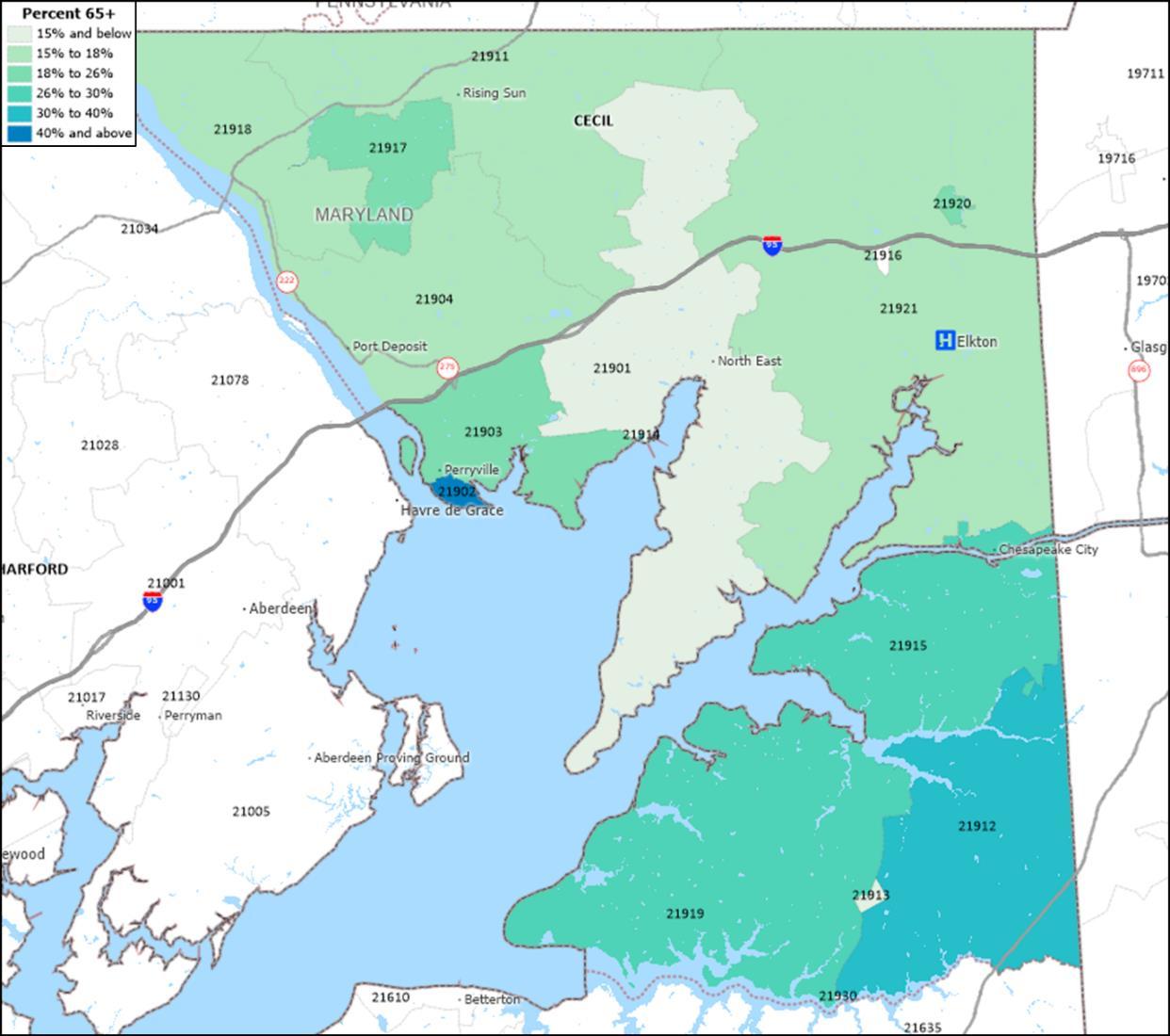
Source: U.S. Census Bureau, 2018-2022, American Community Survey 5-Year Estimates, and Caliper Maptitude, 2024.
Description
Exhibit 7 portrays the percentage of the population 65 years of age and older by ZIP Code. Note that color shading and the legend are specific to this map.
Observations
• In 2018-2022, ZIP Codes 21902 (Perry Point), 21914 (Charlestown), and 21912 (Warwick) had the highest proportions of residents 65 and older (over 30 percent).
Exhibit 8: Percent of Population – Black, 2018-2022
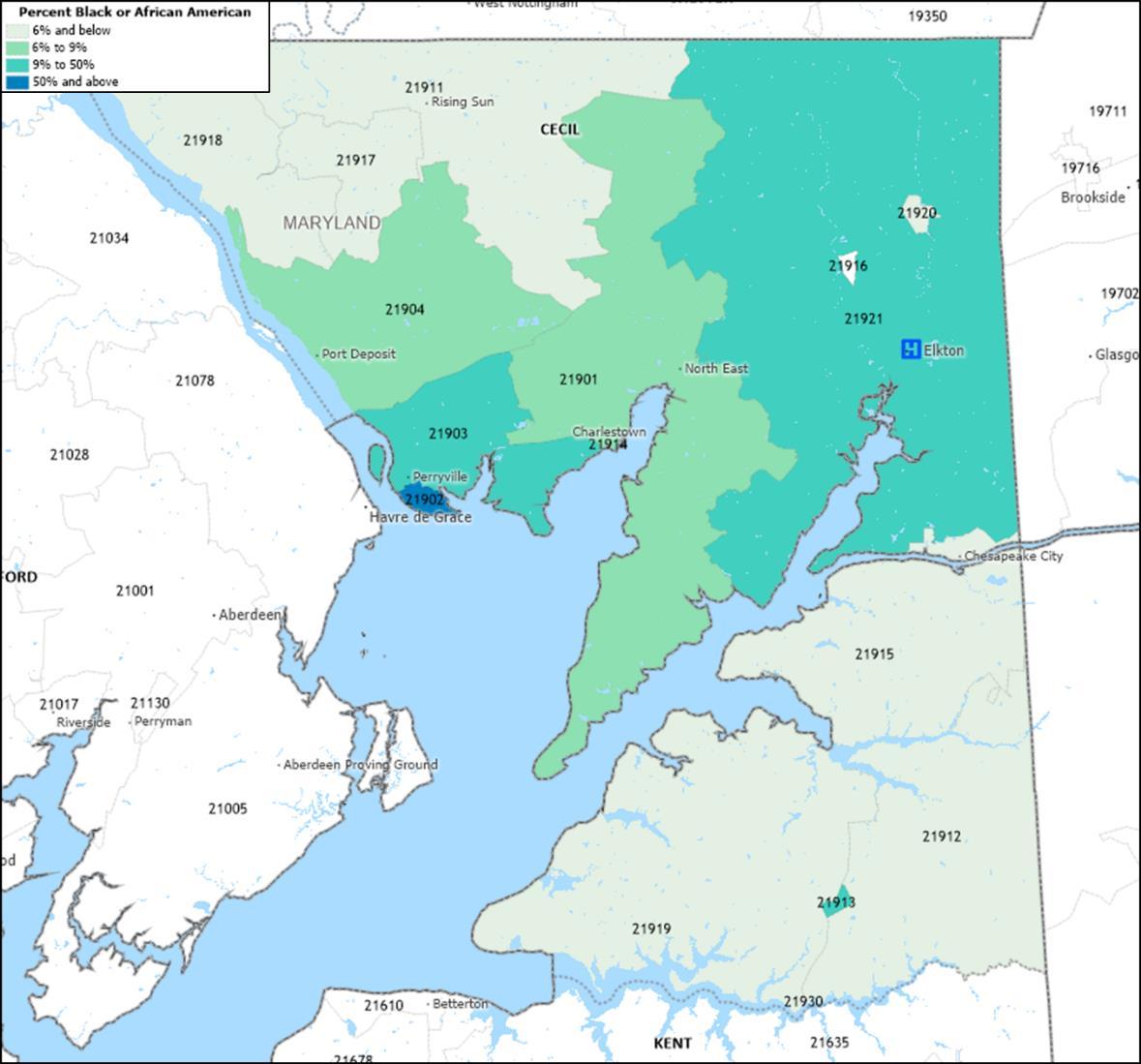
Source: U.S. Census Bureau, 2018-2022, American Community Survey 5-Year Estimates, and Caliper Maptitude, 2024.
Description
Exhibit 8 portrays the percentage of the population – Black by ZIP Code. Note that color shading and the legend are specific to this map.
Observations
• In 2018-2022, ZIP Code 21902 (Perry Point) had the highest proportion of population identified as Black (52.2 percent).
• Cecilton (21913) had the second highest proportion of Black residents at 10.4 percent.
Exhibit 9: Percent of Population – Hispanic (or Latino), 2018-2022

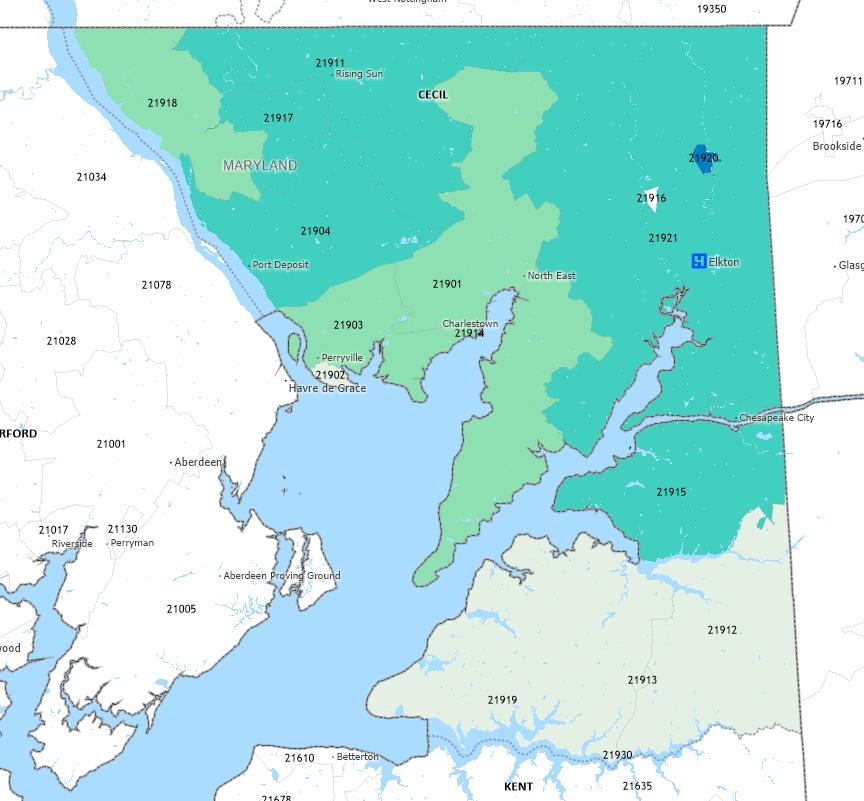
Source: U.S. Census Bureau, 2018-2022, American Community Survey 5-Year Estimates, and Caliper Maptitude, 2024. Description
Exhibit 9 portrays the percent of the population – Hispanic (or Latino) by ZIP Code. Note that color shading and the legend are specific to this map.
Observations
• In 2018-2022, ZIP Code 21920 (Elk Mills) had the highest proportion of Hispanic (or Latino) residents, 16.2 percent.
• The percentage of the population identified as Hispanic (or Latino) was under 10 percent in all other ZIP Codes.
Exhibit 10: Selected Socioeconomic Indicators, 2018-2022
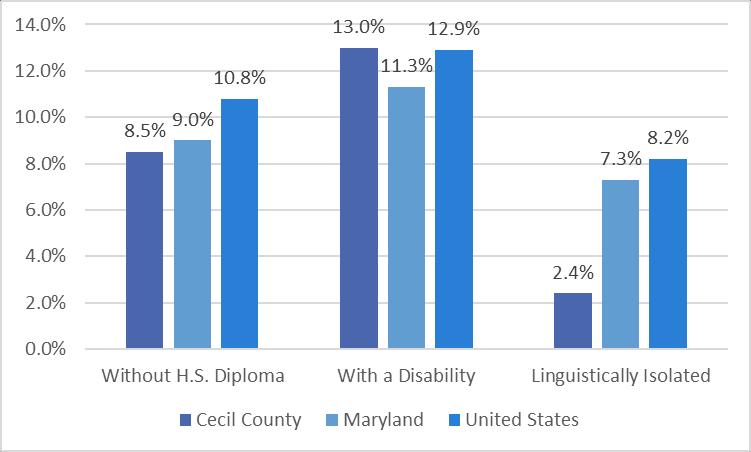
Source: U.S. Census Bureau, 2018-2022, American Community Survey 5-Year Estimates
Description
Exhibit 10 portrays the percent of the population (aged 25 years and above) without a high school diploma, with a disability, and linguistically isolated in Cecil County, Maryland, and the United States. Linguistic isolation is defined as residents who speak a language other than English and who speak English less than “very well.”
Observations
• In 2018-2022, the percentage of residents aged 25 and older without a high school diploma in Cecil County and Maryland was below the national average.
• Cecil County had a higher percentage of population with a disability than Maryland and the United States.
• The percentage of residents linguistically isolated was significantly lower in Cecil County compared to Maryland and the U.S.
Socioeconomic Indicators
This section includes indicators for poverty, food access, unemployment, health insurance status, crime, housing affordability, climate, and “social vulnerability.” All have been associated with health status.
People in Poverty
Exhibit 11: Percent of People in Poverty, 2018-2022
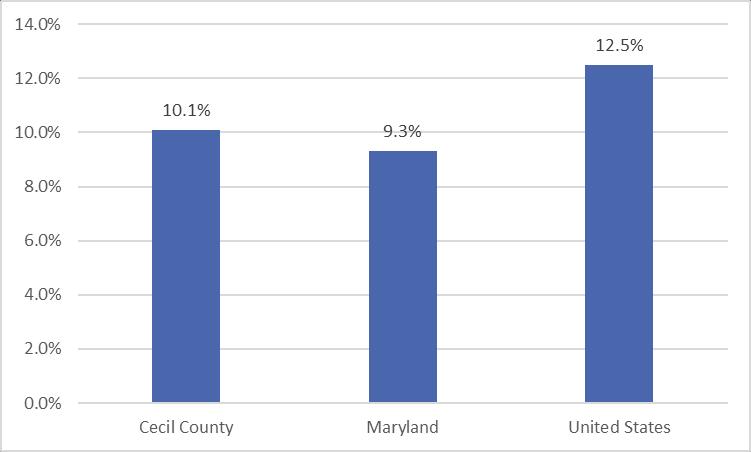
Source: U.S. Census Bureau, 2018-2022, American Community Survey 5-Year Estimates
Description
Exhibit 11 presents poverty rates in Cecil County, Maryland, and the United States.
Observations
• In 2018-2022, the poverty rate in Cecil County was higher than the state average and lower than the national average.
Exhibit 12: Poverty Rates by Race and Ethnicity, 2018-2022
Source: U.S. Census Bureau, 2018-2022, American Community Survey 5-Year Estimates
Description
Exhibit 12 portrays poverty rates by race and ethnicity. Light grey shading indicates rates above the U.S average for all races and ethnicities combined (12.5 percent) and dark grey shading indicates rates more than 50 percent above the U.S. average for all races and ethnicities combined.
Observations
• In 2018-2022, a higher proportion of Cecil County Black, Asian, and Hispanic (or Latino) residents were living in poverty than White residents and residents of all races and ethnicities combined.
Description
Exhibit 13: Child Poverty Rates, 2018-2022
Source: U.S. Census Bureau, 2018-2022, American Community Survey 5-Year Estimates
Exhibit 13 portrays rates for children living in poverty (aged 0-17).
Observations
• In 2018-2022, the percentage of children in poverty in Cecil County was higher than the state average and below the U.S. average.
Exhibit 14: Low Income Census Tracts, 2019
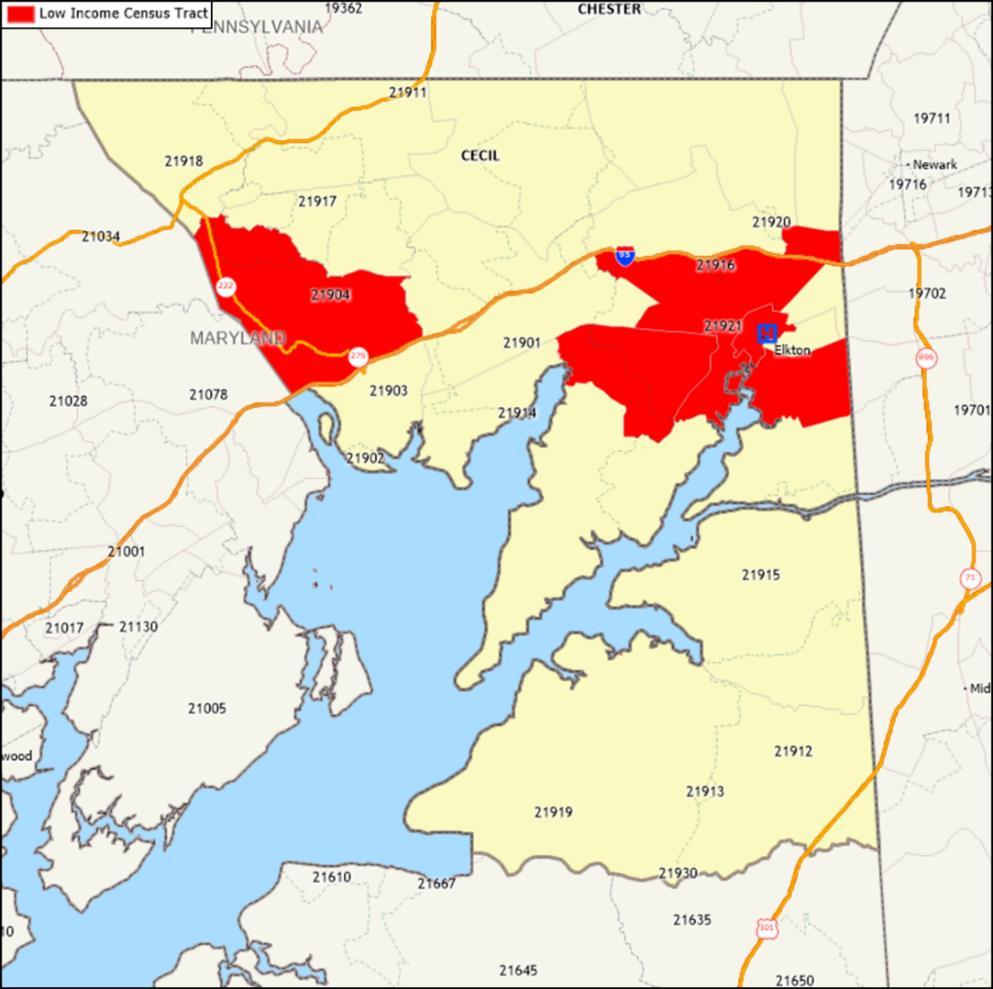
Source: U.S. Department of Agriculture, Economic Research Service, 2019 and Maptitude, 2024.
Description
Exhibit 14 portrays the location of federally designated low-income census tracts.
Observations
• In 2019, federally designated low-income census tracts were present in and around Elkton (proximate to Union Hospital) and Port Deposit.
Exhibit 15: Select Socioeconomic Characteristics, Maryland, LGBT vs. Non-LGBT, 2019
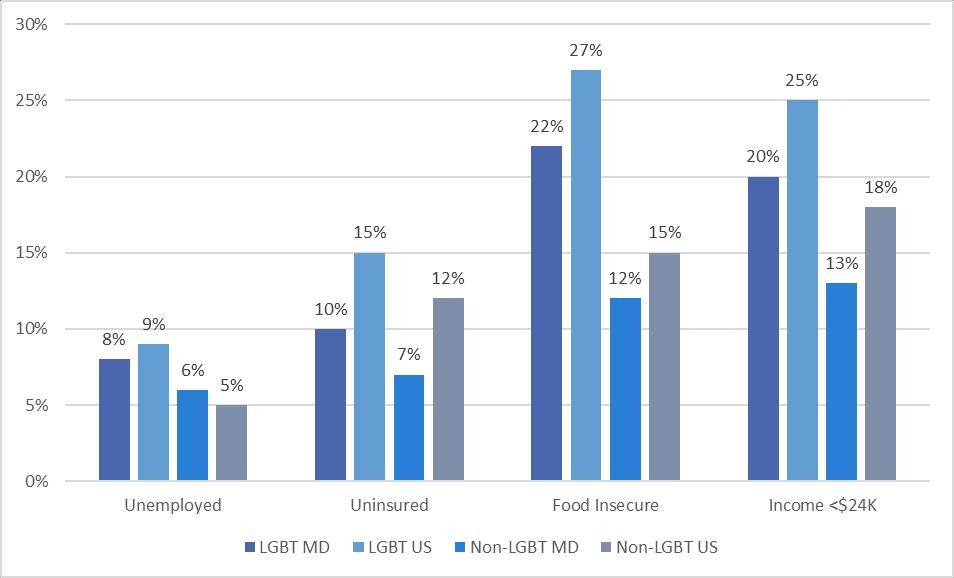
LGBT Demographic Data Interactive, January 2019, Los Angeles, CA: The Williams Institute, UCLA School of Law.
Description
Exhibit 15 presents select socioeconomic indicators for lesbian, gay, bisexual, and transgender (LGBT) communities compared to non-LGBT communities in Maryland and the United States.
Observations
• In 2019, Maryland and U.S. residents who identified as LGBT were more likely to be unemployed, food insecure, and have low-income than those who identified as non-LGBT in the state and nationally.
Food Access
Exhibit 16: Food Insecurity by Race and Ethnicity, 2021-2022
Source: Dewey, A., Harris, V., Hake, M., & Engelhard, E. (2024). Map the Meal Gap 2024: An Analysis of County and Congressional District Food Insecurity and County Food Cost in the United States in 2022. Feeding America. Note: County and state data (2021); national data (2022).
Description
Exhibit 16 portrays food insecurity estimates disaggregated by race and ethnicity and overall food insecurity rates for children in Cecil County, Maryland, and the United States. Dark grey shading indicates rates 50 percent or more above the U.S-wide average of 13.5 percent for all persons. Light grey shading indicates rates 0-50 percent above the U.S. average.
Observations
• In 2021, the overall food insecurity rates in Cecil County and Maryland were lower than the national average for all people.
• Food insecurity rates for Black residents were higher in Cecil County and Maryland compared to the U.S.-wide rate for all people.
Exhibit 17: Low-Income and Low-Access to Healthy Food Census Tracts, 2019
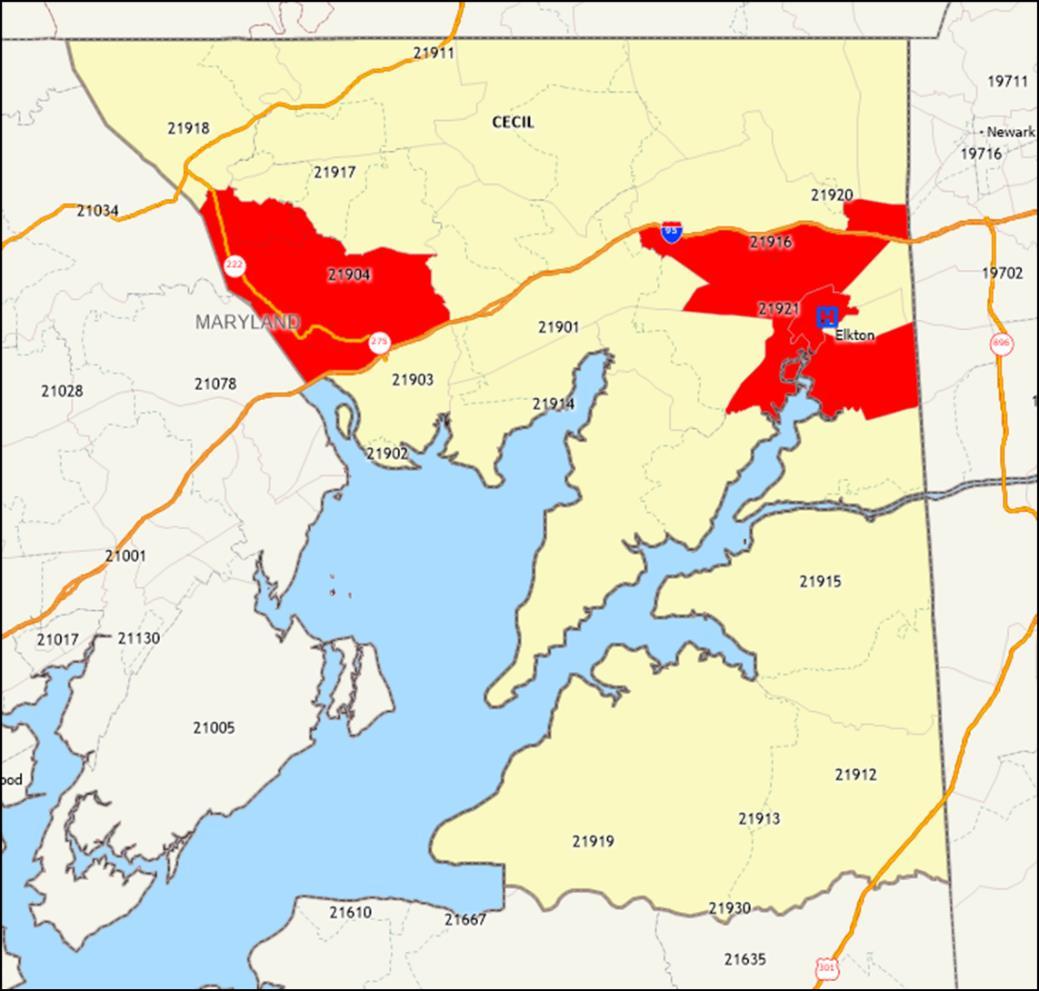
Source: Economic Research Service (ERS), U.S. Department of Agriculture (USDA). Food Access Research Atlas, https://www.ers.usda.gov/data-products/food-access-research-atlas/, 2021 and Caliper Maptitude, 2024.
Description
The U.S. Department of Agriculture’s (USDA) Economic Research Service defines areas as low income and low access by measuring distance to a grocery store or supermarket and the average income of the neighborhood. The USDA defines low access as more than one mile from a supermarket or large grocery store in urban areas and more than 10 miles from a supermarket or large grocery store in rural areas. Limited access to supermarkets, grocery stores, or other sources of healthy and affordable food may make it harder for people to eat a nutritious diet.11
Exhibit 17 identifies areas designated as low-income and low access to healthy and affordable food in Cecil County.
Observations
• In 2019, federally designated low-income and low-access areas were present in and around Elkton (proximate to Union Hospital) and Port Deposit.
11 https://www.ers.usda.gov/data-products/food-access-research-atlas/about-the-atlas/
Unemployment
Exhibit 18: Unemployment Rates, 2019 to 2023
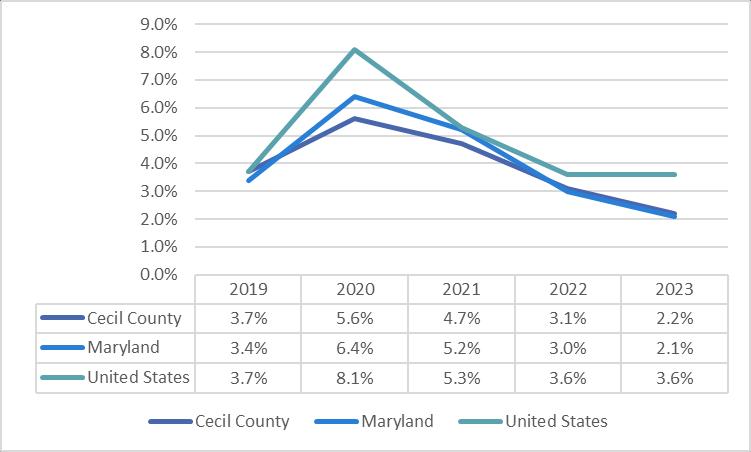
Source: U.S. Bureau of Labor Statistics, 2023.
Description
Exhibit 18 shows unemployment rates in Cecil County, Maryland and the United States from 2019 through 2023.
Observations
• Unemployment rates rose substantially from 2019 to 2020 due to the COVID-19 pandemic; however, declined steadily from 2020 to 2023.
• In 2023, unemployment rates were lower in Cecil County and Maryland compared to national averages.
Housing Affordability
Exhibit 21: Percent of Rented Households Rent Burdened, 2018-2022
Source: U.S. Census Bureau, 2018-2022, American Community Survey 5-Year Estimates
12 Perry Point is home to The Veterans Independence Project (VIP) and provides immediate housing and supportive services to homeless veterans (https://chepinc.org/veteran-housing).
Exhibit 22: Map of Percent of Rented Households Rent Burdened, 2018-2022
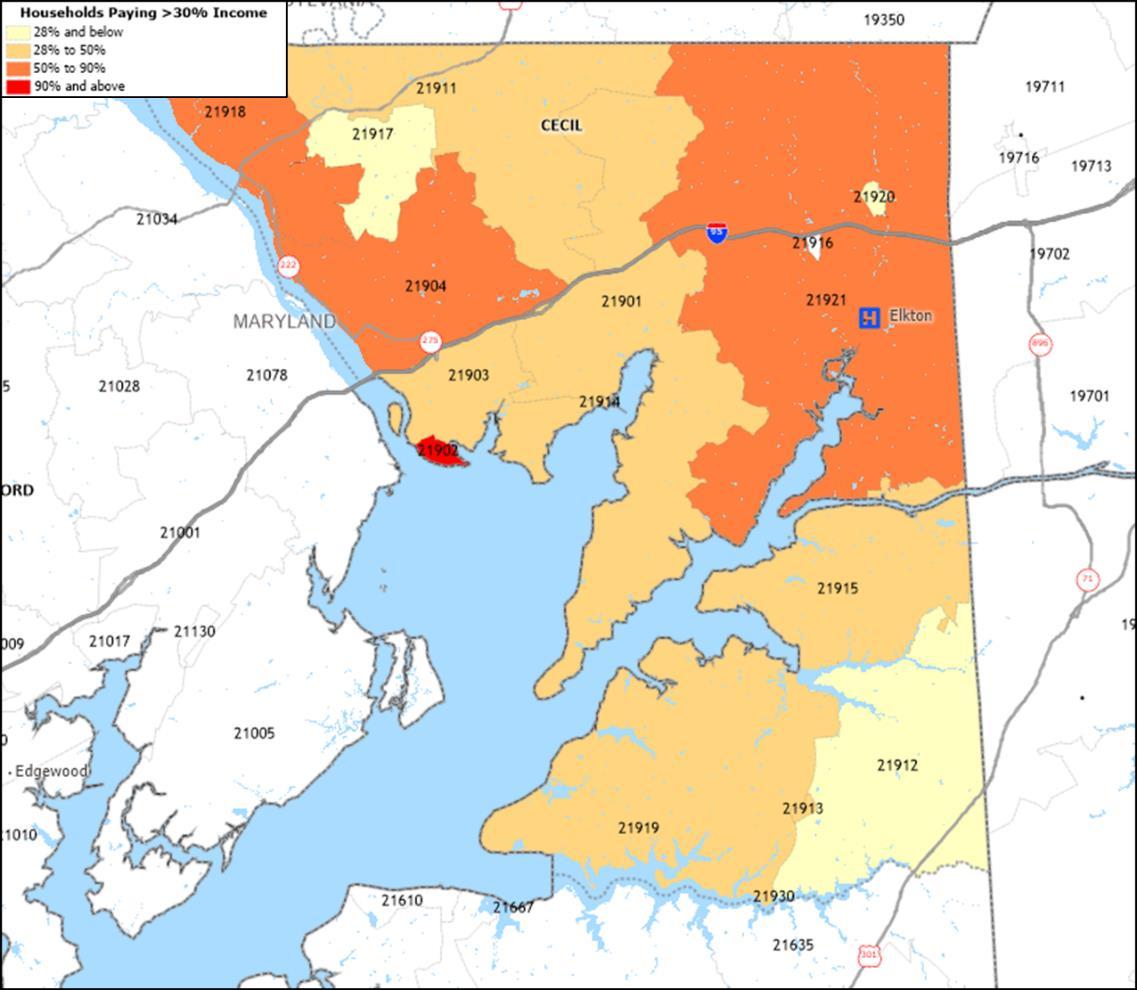
Source: U.S. Census Bureau, 2018-2022, American Community Survey 5-Year Estimates, and Caliper Maptitude, 2024.
Description
The U.S. Department of Housing and Urban Development (HUD) has defined “rent burdened” households as those spending more than 30 percent of income on housing.13
Exhibits 21 and 22 portray the percentage of rented households that meet this definition. Light grey shading in Exhibit 21 indicates ZIP Codes that are above the U.S. average of 49.9 percent for rent burdened households and dark grey indicates ZIP Codes that are more than 50 percent above the average.
Observations
• In 2018-2022, Perry Point (ZIP Code 21902) and Charlestown (ZIP Code 21914), two small communities, had 70 to 100 percent of households designated as rent burdened.
13 https://www.federalreserve.gov/econres/notes/feds-notes/assessing-the-severity-of-rentburden-on-low-income-families-20171222.htm
• In ZIP Codes 21918 (Conowingo), 21921 (Elkton), and 21904 (Port Deposit), more than half of households were designated as rent burdened, exceeding the national rate of 49.9 percent.
Area Deprivation Index
Exhibit 23: Area Deprivation Index by Census Block Group, 2020
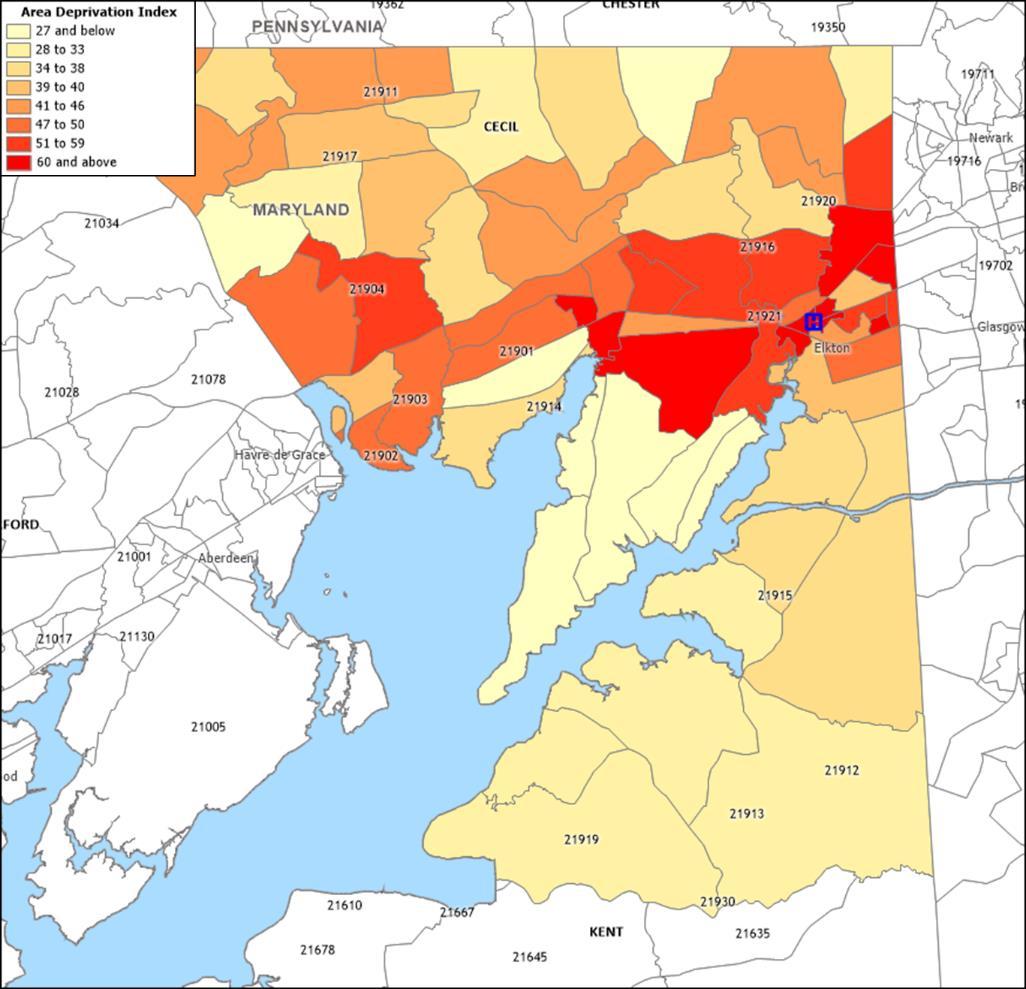
Source: University of Wisconsin School of Medicine and Public Health. Area Deprivation Index, 2021. Downloaded from https://www.neighborhoodatlas.medicine.wisc.edu/, March 21, 2024, and Caliper Maptitude, 2024.
Description
Exhibit 23 presents the University of Wisconsin, School of Medicine and Public Health, Center for Health Disparities Research’s Area Deprivation Index (ADI). The ADI ranks neighborhoods by level of socioeconomic disadvantage and includes factors for income, education, employment, and housing quality.
ADIs are calculated for census block groups in national percentile rankings from 1 to 100. A block group ranking of 1 indicates the lowest level of disadvantage within the nation and an ADI ranking of 100 indicates the highest level of disadvantage.
Observations
• In 2020, neighborhoods in Elkton, Perry Point, Perryville, Port Deposit, and North East had the highest levels of socioeconomic disadvantage.
Centers for Disease Control and Prevention Social Vulnerability Index
Exhibit 24: Socioeconomic Status - Bottom Quartile Census Tracts, 2020
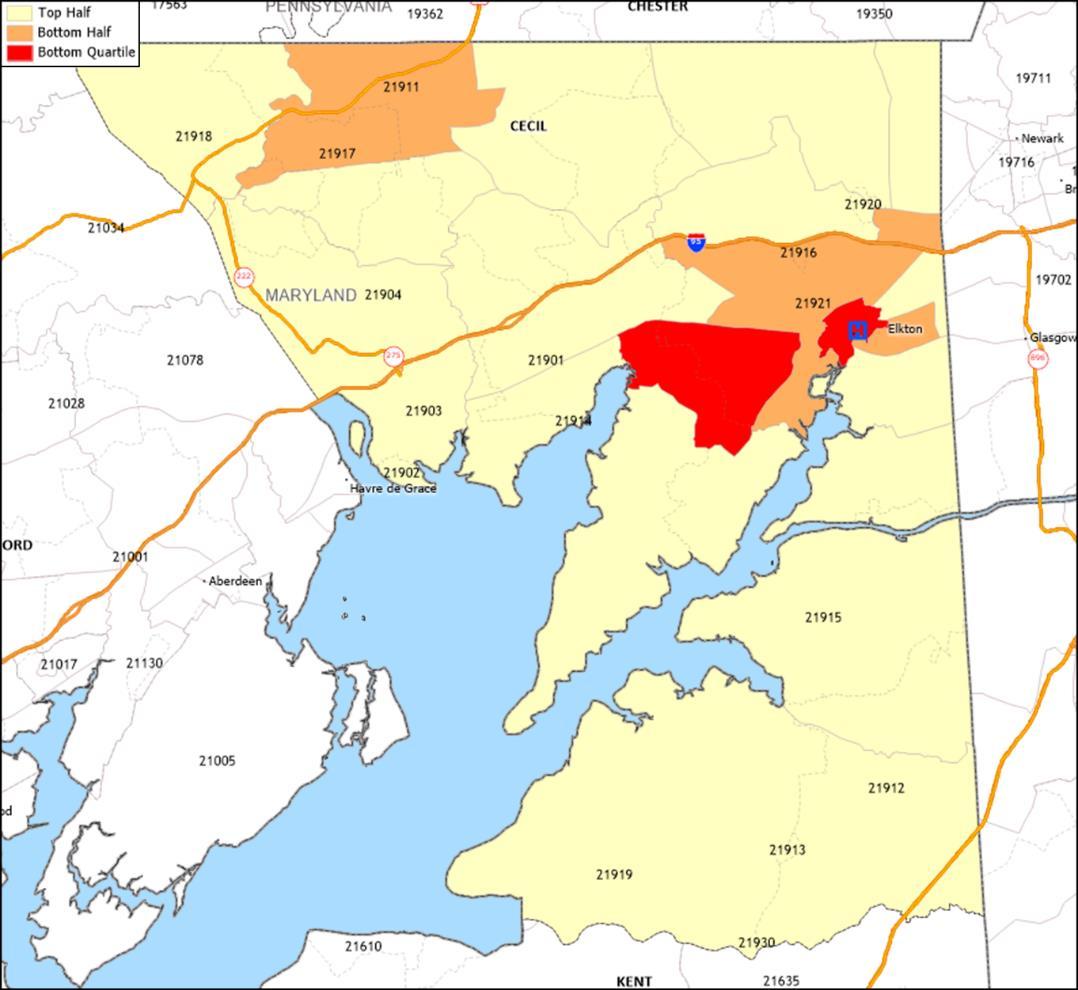
Source: Centers for Disease Control and Prevention, 2020, and Caliper Maptitude, 2024.
Description
Exhibits 24 through 27 are maps that show the Centers for Disease Control and Prevention’s (CDC) Social Vulnerability Index (SVI) scores by census tract. Red highlighted census tracts indicate scores that are in the bottom quartile nationally. The SVI is based on 15 variables derived from U.S. census data and grouped into four themes, including Socioeconomic Status; Household Characteristics; Racial & Ethnic Minority Status; and Housing Type & Transportation.
Exhibit 24 identifies census tracts in the bottom half and bottom quartile for “socioeconomic characteristics,” specifically below 150 percent of poverty, unemployment, housing cost burden, no high school diploma, no health insurance.
Observations
• In 2020, census tracts with the highest socioeconomic vulnerability were present in and around Elkton and North East.
Exhibit 25: Household Characteristics – Bottom Quartile Census Tracts, 2020
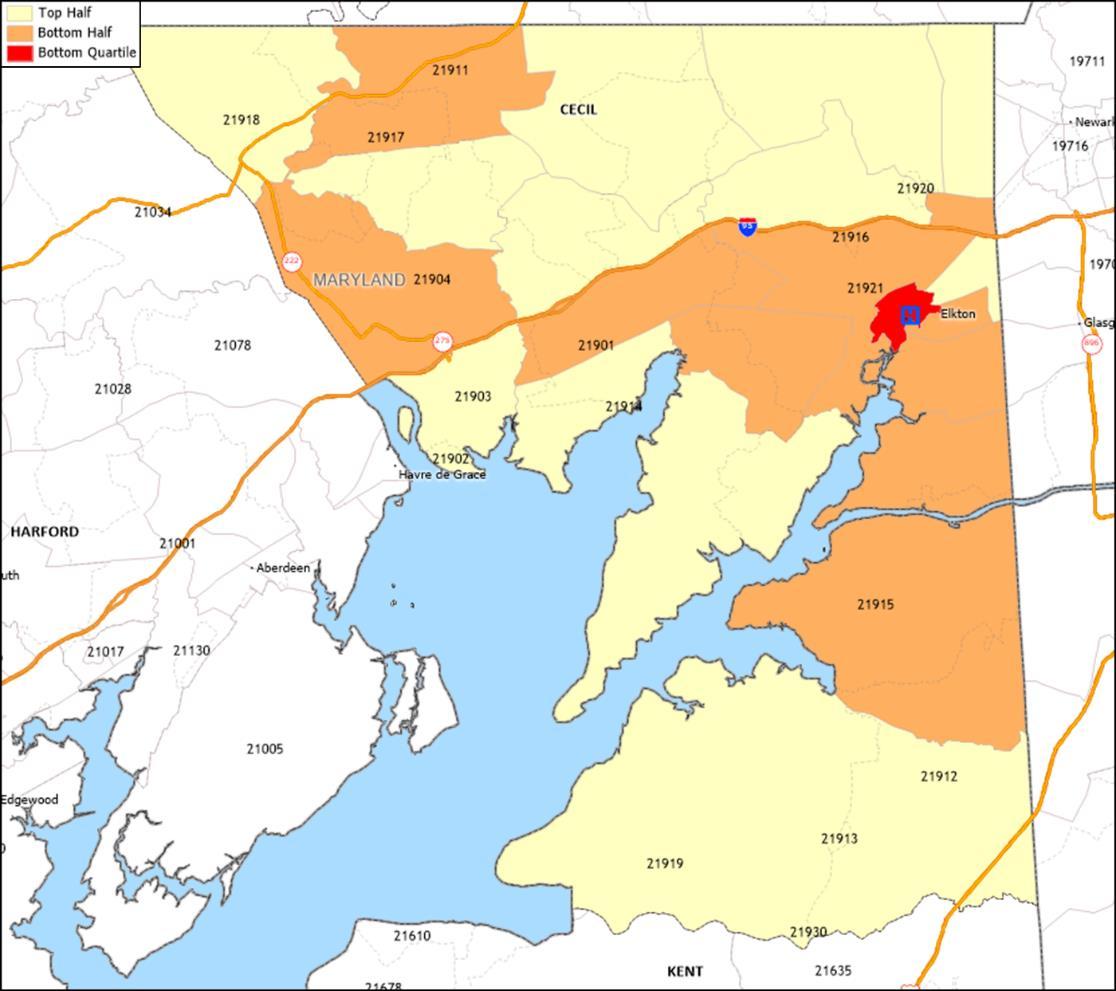
Source: Centers for Disease Control and Prevention, 2020, and Caliper Maptitude, 2024.
Description
Exhibit 25 identifies census tracts in the bottom half and bottom quartile nationally for “household characteristics,” specifically percent of people 65 years of age or older, 17 years of age or younger, civilian with a disability, single-parent households, and with Limited English Proficiency (LEP).
Observations
• In 2020, census tracts with the highest household characteristics vulnerability were concentrated in Elkton.
• Census tracts in Rising Sun, Colora, North East, and Chesapeake City had higher levels of household characteristics vulnerability compared to U.S. averages.
Exhibit 26: Racial and Ethnic Minority Status – Bottom Quartile Census Tracts, 2020
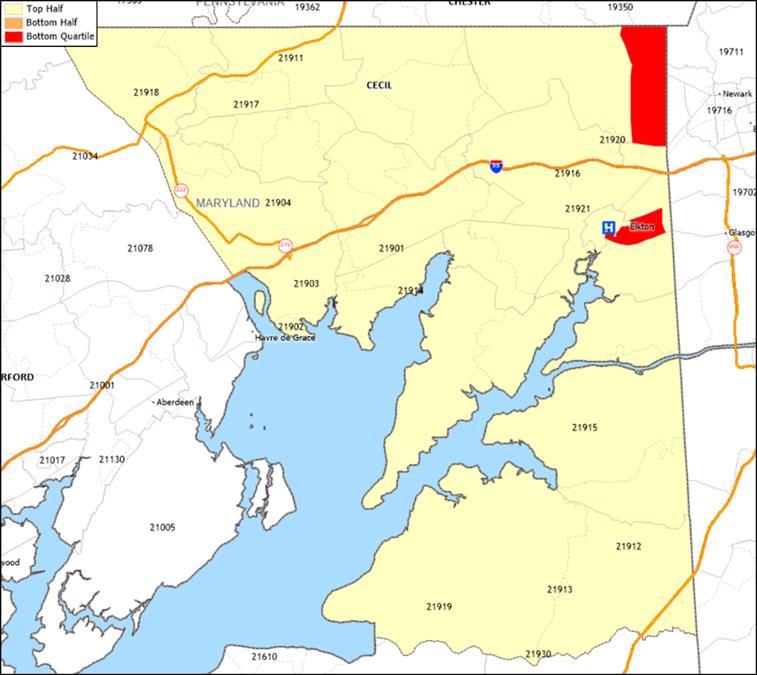
Source: Centers for Disease Control and Prevention, 2020, and Caliper Maptitude, 2024.
Description
Exhibit 26 identifies census tracts in the bottom half and bottom quartile for “racial and ethnic minority status,” specifically percent of people identified as non-White.
Observations
• In 2020, census tracts with the highest racial and ethnic minority status vulnerability were in Elkton and northeast Cecil County.
Exhibit 27: Housing Type and Transportation – Bottom Quartile Census Tracts, 2020
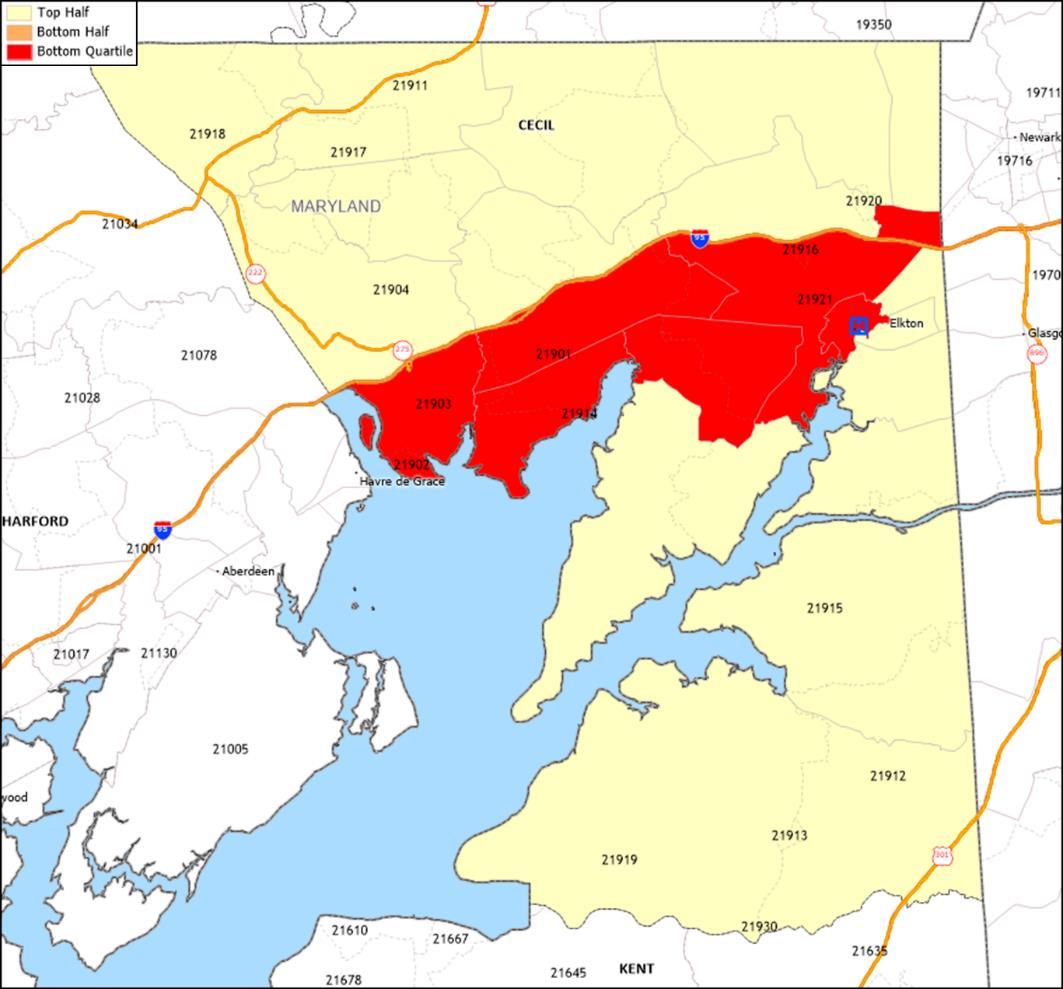
Source: Centers for Disease Control and Prevention, 2020, and Caliper Maptitude, 2024.
Description
Exhibit 27 identifies census tracts in the bottom half and bottom quartile nationally for “housing type and transportation vulnerability,” specifically people living in multi-unit structures, in mobile homes, in crowded households, in group quarters, and with no vehicle.
Observations
• In 2020, census tracts designated as vulnerable for housing type and transportation were present in North East, Perry Point, Perryville, Charlestown, and Elkton.
Centers for Disease Control and Prevention Heat and Health Index
Exhibit 28: Heat and Health Index by ZIP Code, 2018-2022
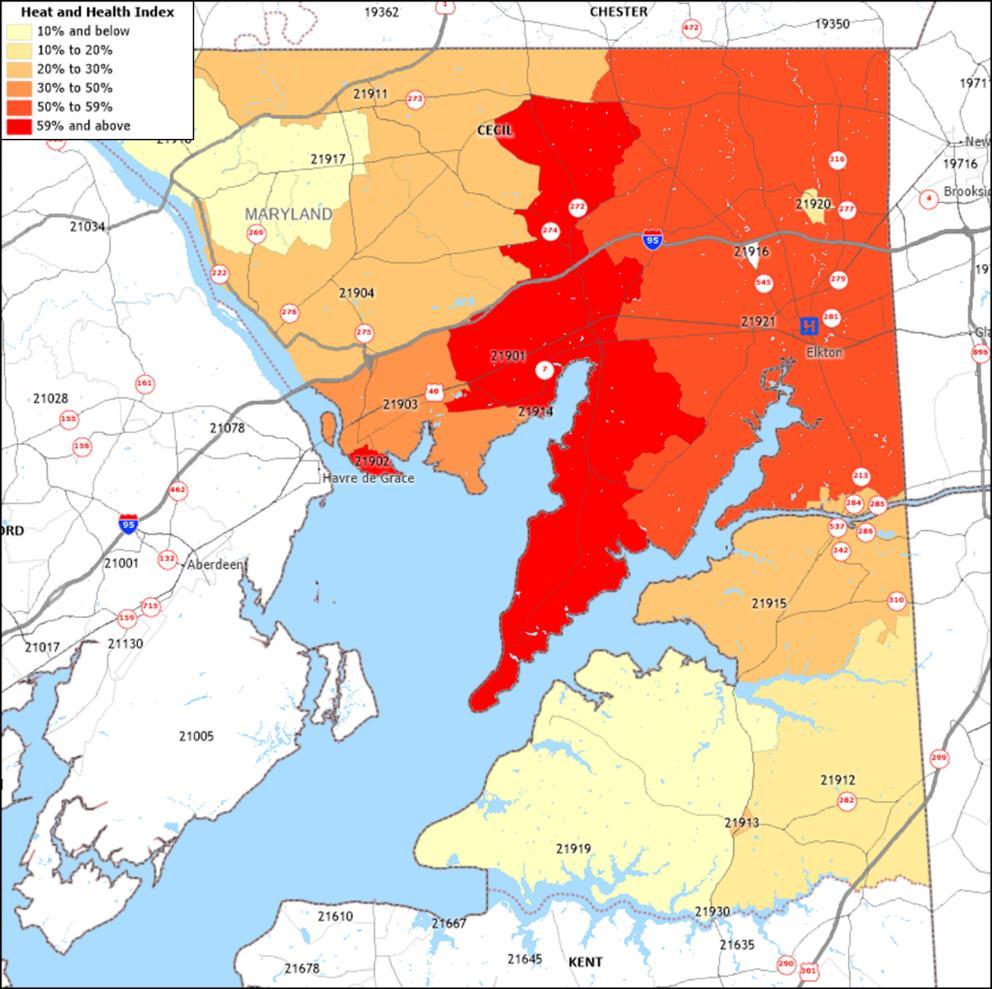
Source: Centers for Disease Control and Prevention, Climate & Health Program, Heat and Health Tracker, 2018-2022. Accessed from: https://ephtracking.cdc.gov/DataExplorer on 09/12/2024, and Caliper Maptitude, 2024.
Description
Exhibit 28 presents the Centers for Disease Control and Prevention’s Heat and Health Index (HHI) by ZIP Code. The HHI ranks ZIP Codes by level of risk for negative outcomes from heat and includes factors for previous experience with heat, pre-existing health conditions, social and demographic characteristics, and natural and built environment characteristics. HHIs are provided in national percentile rankings from 1 to 100, with 1 indicating the lowest level of risk and 100 indicating the highest level of risk.
Observations
• In 2018-2022, ZIP Codes 21901 (North East), 21902 (Perry Point), and 21903 (Perryville) had the highest levels of risk for negative outcomes due to heat in Cecil County
Other Health Status and Access Indicators
County Health Rankings
Exhibit 29: County Health Rankings, Health Outcomes, 2024
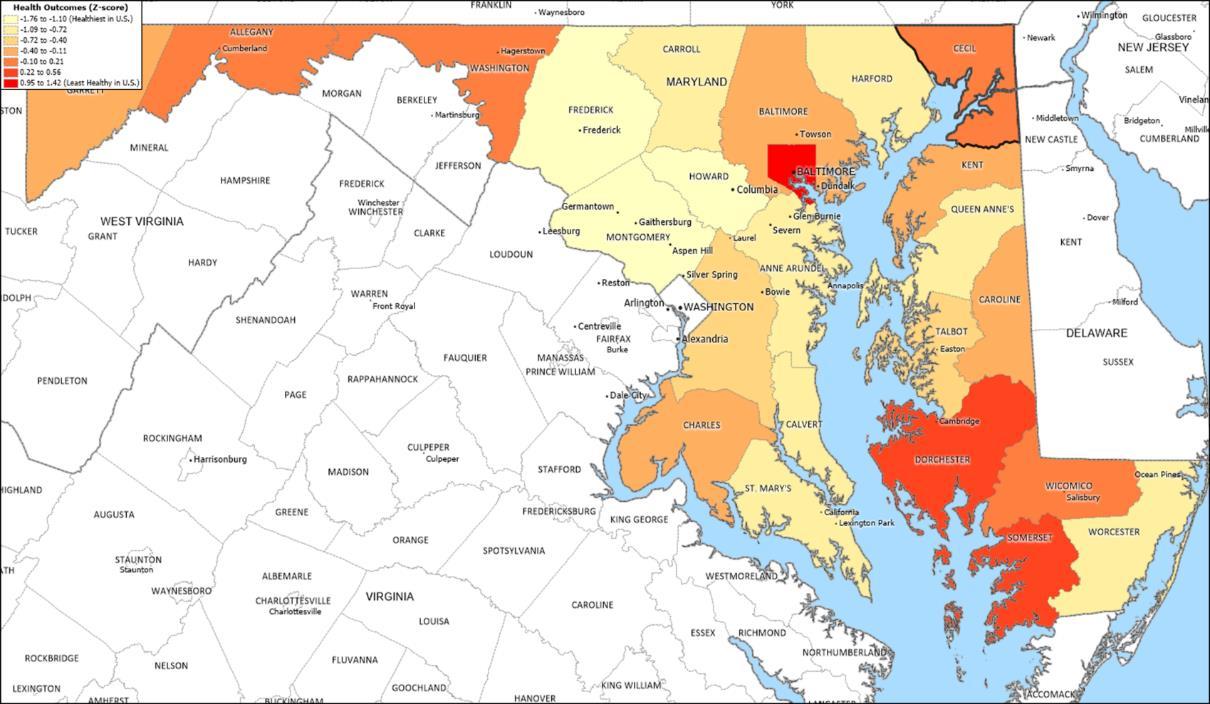
Source: County Health Rankings, 2024 and Caliper Maptitude, 2024.
Description
Exhibit 29 presents data from County Health Rankings, a University of Wisconsin Population Health Institute initiative funded by the Robert Wood Johnson Foundation that incorporates a variety of indicators to assess “health factors” and “health outcomes” of counties across the United States. The health factors and outcomes are composite measures based on several variables grouped into the following categories: Health behaviors, clinical care,14 social and economic factors, and physical environment.15 County Health Rankings is updated annually. County Health Rankings 2024 relies on data from 2015 to 2023. Most data are from 2018 to 2022 The exhibit presents “health outcomes” assessments for Maryland counties relative to other counties across the United States.
14A composite measure of Access to Care, which examines the percentage of the uninsured population and ratios primary care physicians, dentists, and mental health providers and Quality of Care, which examines preventable hospitalization rates, mammography screening, and flu vaccination rates.
15A composite measure that examines Environmental Quality, which measures air pollution and drinking water violations, and Built Environment, which measures severe housing problems and driving alone to work.
Observations
• In 2024, Cecil County was assessed as faring worse than the average county in Maryland for Health Outcomes, and about the same as the average county in the nation.
Exhibit 30: County Health Rankings Data Compared to State and U.S. Averages, 2024
Health Factors
Source: County Health Rankings, 2024.
Exhibit 30: County Health Rankings Data Compared to State and U.S. Averages, 2024 (continued)
Source:
Description
Exhibit 30 provides data that underlie the County Health Rankings and compares indicators to statewide and national averages 16 Light grey shading highlights indicators found to be worse than the national average; dark grey shading highlights indicators more than 50 percent worse.
Note that higher values generally indicate that health outcomes, health behaviors, and other factors are worse in the county than in the United States. However, for several indicators, lower values are more problematic, including food environment index, percent with access to exercise opportunities, percent receiving mammography screening, percent receiving flu vaccination, high school graduation rate, and percent with some college.
Observations
• The following indicators compared unfavorably to U.S. averages:
o Years of potential life lost before age 75 per 100,000 population
o Percent of adults reporting fair or poor health
o Average number of physically and mentally unhealthy days
o Percent of adults smoking
o Percent of adults that report a BMI greater than 30
o Percent of adults aged 20 and over reporting no leisure-time physical activity
o Percent of population with adequate access to exercise opportunities
o Per capita supply of mental health providers
o Preventable hospitalizations
o Mammography screening
o Percent of adults aged 25-44 years with some post-secondary education
o Number of social associations per 10,000 population
o Injury mortality per 100,000 population
o Percent of the workforce that drives alone to work
• The per capita supply of primary care physicians and dentists was particularly problematic with almost double the ratio of population to provider compared to U.S. rates.
16 https://www.countyhealthrankings.org/health-data/county-health-rankings-measures
Community Health Status Indicators
Exhibit 31: Community Health Status Indicators, 2024
Source: County Health Rankings and Verité Analysis, 2024
Description: County Health Rankings has assembled community health data for all 3,143 counties in the United States. Following a methodology developed by the CDC, Community Health Status Indicators Project (CHSI), County Health Rankings also publishes lists of “peer counties” so comparisons with peer counties in other states can be made. Each county in the U.S. is assigned 30 to 35 peer counties based on 19 variables including population size, population growth, population density, household income, unemployment, percent children, percent elderly, and poverty rates
CHSI formerly was available from the CDC. Because comparisons with peer counties (rather than only counties in the same state) are meaningful, Verité Healthcare Consulting rebuilt the CHSI comparisons for this and other CHNAs.
Exhibit 31 compares Cecil County to its respective peer counties and highlights community health issues found to rank in the bottom half and bottom quartile of the counties included in the analysis. Light grey shading indicates rankings in the bottom half of peer counties; dark grey shading indicates rankings in the bottom quartile of peer counties. Underlying statistics also are provided.
See Appendix D for a list of Cecil County’s peer counties.
Note that higher values generally indicate that health outcomes, health behaviors, and other factors are worse in the county than in its peer counties. However, for several indicators, lower values are more problematic, including:
• Food environment index,
• Percent with access to exercise opportunities,
• Percent receiving mammography screening,
• Percent receiving flu vaccination,
• High school graduation rate, and
• Percent with some college.
Observations
• Cecil County compared unfavorably to peer counties for nineteen (19) of the 33 benchmark indicators.
• Cecil County ranked in the bottom quartile of peer counties for nine (9) of the 33 indicators:
o Years of potential life lost before age 75 per 100,000 population
o Average number of mentally unhealthy days
o Percent of live births with low birthweight
o Healthy food environment
o Mammography screening
o Income equality ratio
o Number of social associations
o Injury mortality per 100,000 population
o Severe housing problems
COVID-19
Incidence and Mortality
Exhibit 32: COVID-19 Incidence and Mortality (As of March 10, 2023)
Source: Johns Hopkins University. Accessed via ESRI. Additional data analysis by CARES. 2022.
Description
Exhibit 32 presents data regarding COVID-19 incidence and mortality. Light grey shading highlights indicators found to be worse than the national average
Observations
• As of March 2023, Cecil County experienced a COVID-19 mortality rate higher than Maryland and lower than the United States.
Causes of Death
Exhibit 33: Causes of Death, Age-adjusted Rates (per 100,000 population), 2015-2020
Source: Centers for Disease Control and Prevention, National Center for Health Statistics, National Vital Statistics System, Mortality 1999-2020 on CDC WONDER Database, released in 2021.
Description
Exhibit 33 provides age-adjusted mortality rates for underlying causes of death, grouped by the 15 leading causes. Light grey shading indicates rates above U.S. averages; dark grey shading indicates rates more than 50 percent above the U.S.
Observations
• In 2015-2020, Cecil County rates for 10 out of the leading 15 causes of death were above U.S. averages.
• Rates for cerebrovascular diseases were particularly high compared to state and U.S. averages.
Exhibit 34: Cancer Mortality, Age-adjusted Rates (per 100,000 population), 2015-2020
Source: Centers for Disease Control and Prevention, National Center for Health Statistics, National Vital Statistics System, Mortality 1999-2020 on CDC WONDER Database, released in 2021.
Description
Exhibit 34 provides age-adjusted mortality rates for selected forms of cancer in 20152020.
Observations
• In 2015-2020, Cecil County had above average, overall cancer mortality rates compared to Maryland and the U.S.
• Cecil County had particulary high rates of bronchus or lung, bladder, esophagus, and liver cancer mortality compared to Maryland and U.S. averages.
Exhibit 35: Poisoning Mortality (per 100,000 population), 2018-2022
Source: Centers for Disease Control and Prevention, National Vital Statistics System, Accessed via CDC WONDER. 20182022.
Description
Exhibit 35 presents the 2018-2022 five-year average rate of death due to poisoning (including drug overdose) per 100,000 population. Dark grey shaded indicates rates more than 50 percent above U.S. rates.
Observations
• Between 2018-2022, Cecil County and Maryland had significantly higher five-year average poisoning mortality rates compared to the U.S.
Exhibit 36: Poisoning Mortality (per 100,000 population) by Gender, 2018-2022
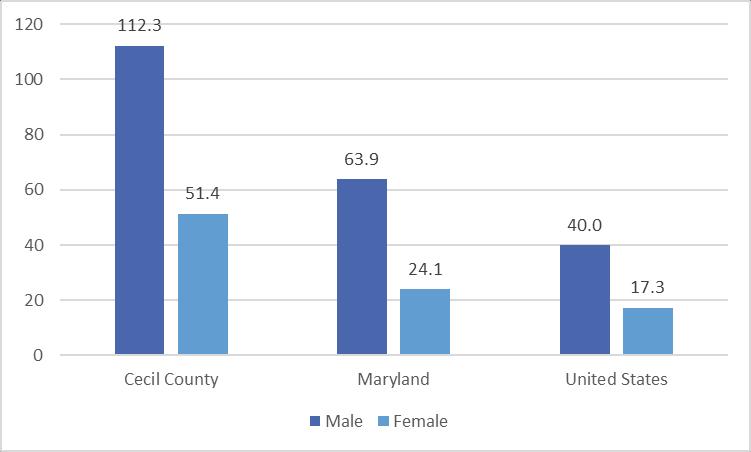
Source: Centers for Disease Control and Prevention, National Vital Statistics System, Accessed via CDC WONDER. 20182022.
Description
Exhibit 36 displays crude mortality rates from deaths due to poisoning (including drug poisoning), per 100,000 population, grouped by gender.
Observations
• In 2018-2022, deaths due to poisoning, including drug overdose, were more than double for males compared to females in Cecil County and Maryland.
• Cecil County male death rate due to poisoning was 2.8 times that of the U.S.-wide rate for males and over 6.0 times the rate of female deaths due to poisoning.
Exhibit 37: Suicide Deaths (per 100,000 population), 2018-2022
Source: Centers for Disease Control and Prevention, National Vital Statistics System, Accessed via CDC WONDER. 20182022.
Description
Exhibit 37 presents the 2018-2022 five-year average rate of death due to intentional selfharm (suicide) per 100,000 population.
Observations
• Between 2018-2022, suicide rates were higher in Cecil County compared to state and national averages.
Communicable Diseases
Exhibit 38: Communicable Disease Incidence Rates (per 100,000 population), 2022
Source: Source: Centers for Disease Control and Prevention, National Center for HIV/AIDS, Viral Hepatitis, STD, and TB Prevention. 2022
Description
Exhibit 38 presents incidence rates for certain communicable diseases.
Observations
• In 2022, Cecil County incidence rates for communicable diseases were lower than state and national averages for all measures.
• Chlamydia infections and HIV prevalence were higher in Maryland compared to U.S. averages.
Maternal and Child Health
Exhibit 39: Low Birthweight Births by Race and Ethnicity, 2016-2022
Source: University of Wisconsin Population Health Institute, County Health Rankings. 2016-2022.
Description
Exhibit 39 presents the 2016-2022 average percentage of live births where the infant weighed less than 2,500 grams (approximately 5 pounds, 8 ounces) by race and by Hispanic origin. Light grey shading indicates measures that are above the U.S. average for low birthweight births of all races and ethnicities.
Observations
• Between 2016-2022, Cecil County had a lower percentage of low-birth weight babies for all races and ethnicities combined compared to the U.S.
• Low birthweight births for non-Hispanic Black residents were significantly higher for all areas presented compared to the U.S. average for low birthweight babies of all races and ethnicities.
Exhibit 40: Number of Births (per 1,000 female population), Age 15-19, 2016-2022
Source: Centers for Disease Control and Prevention, CDC - National Vital Statistics System. Accessed via County Health Rankings. 2016-2022
Description
Exhibit 40 presents the seven-year average (2016-2022) number of births per 1,000 female population age 15-19 by race and Hispanic origin.
Observations
• Between 2016-2022, average rates for teen mothers giving birth were slightly higher in Cecil County for all races and ethnicities combined compared to the U.S.
• Rates for non-Hispanic Black and Hispanic (or Latino) teen mothers giving birth were higher than non-Hispanic White teen mothers in all areas presented.
Exhibit 41: Infant Mortality Rates per 1,000 Live Births, 2018-2022
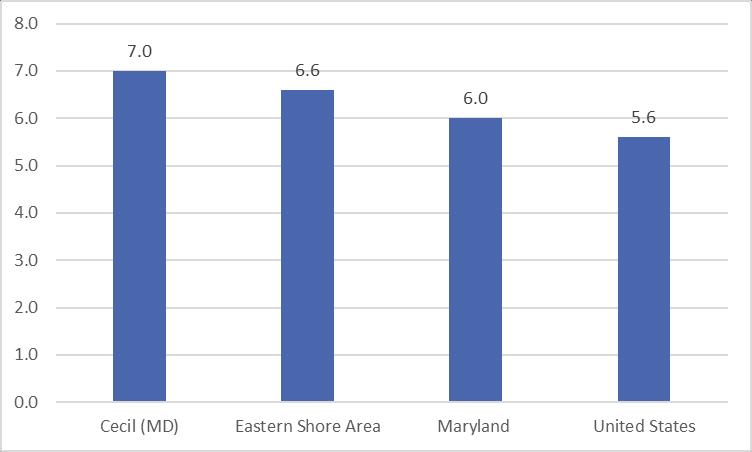
Source: Maryland Department of Health, Vital Statistics Report, 2022.
Description
Exhibit 41 presents infant mortality rates in Cecil County, Eastern Shore Area, and Maryland with the United States for comparison.
Observations
• In 2018-2022, Cecil County infant mortality rates were higher than the Eastern Shore Area, Maryland, and U.S. averages.
Exhibit 42: Maryland Infant Mortality Rates per 1,000 Live Births by Race and Ethnicity, 2022
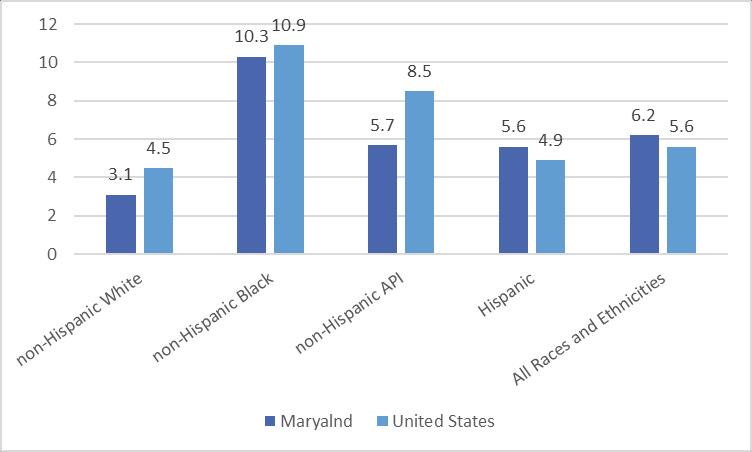
Source: Maryland Department of Health, Vital Statistics Report, 2022.
Description
Exhibit 42 compares infant mortality rates in Maryland and the United States by race and ethnicity.
Observations
• In 2022, Maryland infant mortality rates for non-Hispanic Black residents (10.3), non-Hispanic Asian or Pacific Islander (API) residents 95.7), and for all races and ethnicities combined (6.2) was higher than the U.S.-wide average (5.6) for all people.
Adverse Childhood Experiences (ACEs)
Exhibit 43: Prevalence of Adverse Childhood Experiences, Maryland BRFSS, 2020
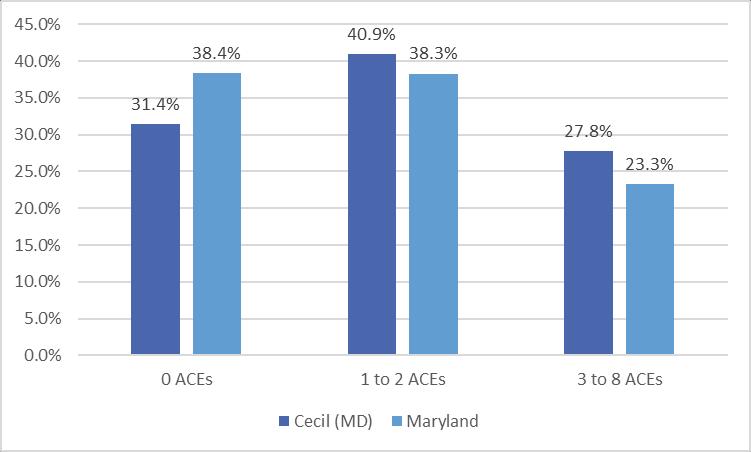
Source: Maryland Behavioral Risk Factor Surveillance System (BRFSS), 2020.
Description
Exhibit 43 presents the prevalence of adverse childhood experiences (ACEs) among Cecil County and Maryland adults by number of ACEs.
Observations
• In 2020, Cecil County had a higher prevalence of adults reporting 1 to 2 ACEs and more than 3 ACEs compared to Maryland and the U.S. The ACE score prevalence among U.S. adults between 2001-2020 was 23.5 percent for 2-3 ACEs, and 17.3 percent for 4 or more ACEs.17
17 https://www.cdc.gov/violenceprevention/aces/ace-brfss.html
Centers for Disease Control and Prevention PLACES
Exhibit 44: CDC PLACES, Health Outcomes Measure, 2023
Source: CDC, 2023, and Verité analysis.
Description: Exhibits 44 through 48 present CDC’s PLACES data. PLACES data are derived from BRFSS and are available for every U.S. ZIP Code, census tract, county, and state. Thirty measures are grouped into five categories: Health Outcomes (13 measures), Prevention (10 measures), Health Risk Behaviors (4 measures), Health Status (3 measures), and Disability (7 measures). Light grey shading highlights indicators found to be worse than the national average; dark grey shading highlights indicators more than 50 percent worse.
Exhibit 44 provides data that underlie the Health Outcomes Measure and compares indicators to national averages.18
Observations
• In 2023, nine (9) of thirteen (13) health outcomes indicators for Cecil County compared unfavorably to U.S. averages, including indicators for arthritis, cancer, COPD, coronary heart disease, current asthma, depression, high blood pressure, high cholesterol, and obesity.
• In Perry Point ZIP Code 21902, rates of coronary heart disease, diabetes, and high blood pressure were more than 50 percent above U.S. rates.
• Rates of obesity and arthritis were above U.S. averages in every Cecil County ZIP Code.
18 https://www.cdc.gov/places/methodology/index.html
Exhibit 45: CDC PLACES, Prevention Measure, 2023
Source: CDC, 2023, and Verité analysis.
Description
Exhibit 45 provides data that underlie the Prevention Measure and compares indicators to national averages.
Observations
• In 2023, rates for cervical cancer screening, colon cancer test, mammogram, preventive services for women, compliance with high blood pressure medication, and dental visit were comparatively worse in Cecil County than the U.S.
Exhibit 46: CDC PLACES, Health Risk Behaviors Measure, 2023
Source: CDC, 2023, and Verité analysis.
Description
Exhibit 46 provides data that underlie the Health Risk Behaviors Measure and compares indicators to national averages.
Observations
• In 2023, health risk behaviors indicators compared unfavorably to national rates in most Cecil County ZIP Codes.
Exhibit 47: CDC PLACES, Health Status Measure, 2023
Source: CDC, 2023, and Verité analysis.
Description
Exhibit 47 provides data that underlie the Health Status Measure and compares indicators to national averages.
Observations
• In 2023, Cecil County rates of fair or poor self-rated health status compared favorably to national averages.
• Poor mental and physical health status (>14 days) compared unfavorably in Cecil County to U.S. averages.
Exhibit 48: CDC PLACES, Disability Measure, 2023
Source: CDC, 2023, and Verité analysis.
Description
Exhibit 48 provides data that underlie the Disability Measure and compares indicators to national averages.
Observations
• In 2023, Cecil County rates of any disability type were slightly higher than national rates.
• Perry Point (ZIP Code 21902) and Charlestown (ZIP Code 21914) were above national rates for several disability types.
Youth Risk Behavior Surveillance System
Exhibit 49: Youth Risk Behavior Survey, 2021
Source: Centers for Disease Control and
Unintentional Injuries and Violence
and Other
Exhibit 50: YRBSS Data for Cecil County Gay, Lesbian, and Bisexual Youth, 2021
Source: Centers for Disease Control and Prevention, 2021 and Maryland Department of Health, 2021.
Description
Exhibit 50 presents YRBSS data for Cecil County high school respondents identifying as gay, lesbian, or bisexual compared to students who identified as straight or heterosexual.
Observations
• Youth identified as gay, lesbian, or bisexual were more than twice as likely to report being electronically bullied, bullied on school property, feeling sad or hopeless most days, and seriously considering attempting suicide compared to students who identified as straight or heterosexual.
• High risk behaviors such as tobacco use, alcohol and drug use, and sexual behaviors were also more prevalent amongst students who identified as gay, lesbian, or bisexual.
Medically Underserved Areas and Populations
Exhibit 51: Locations of Medically Underserved Areas, 2025
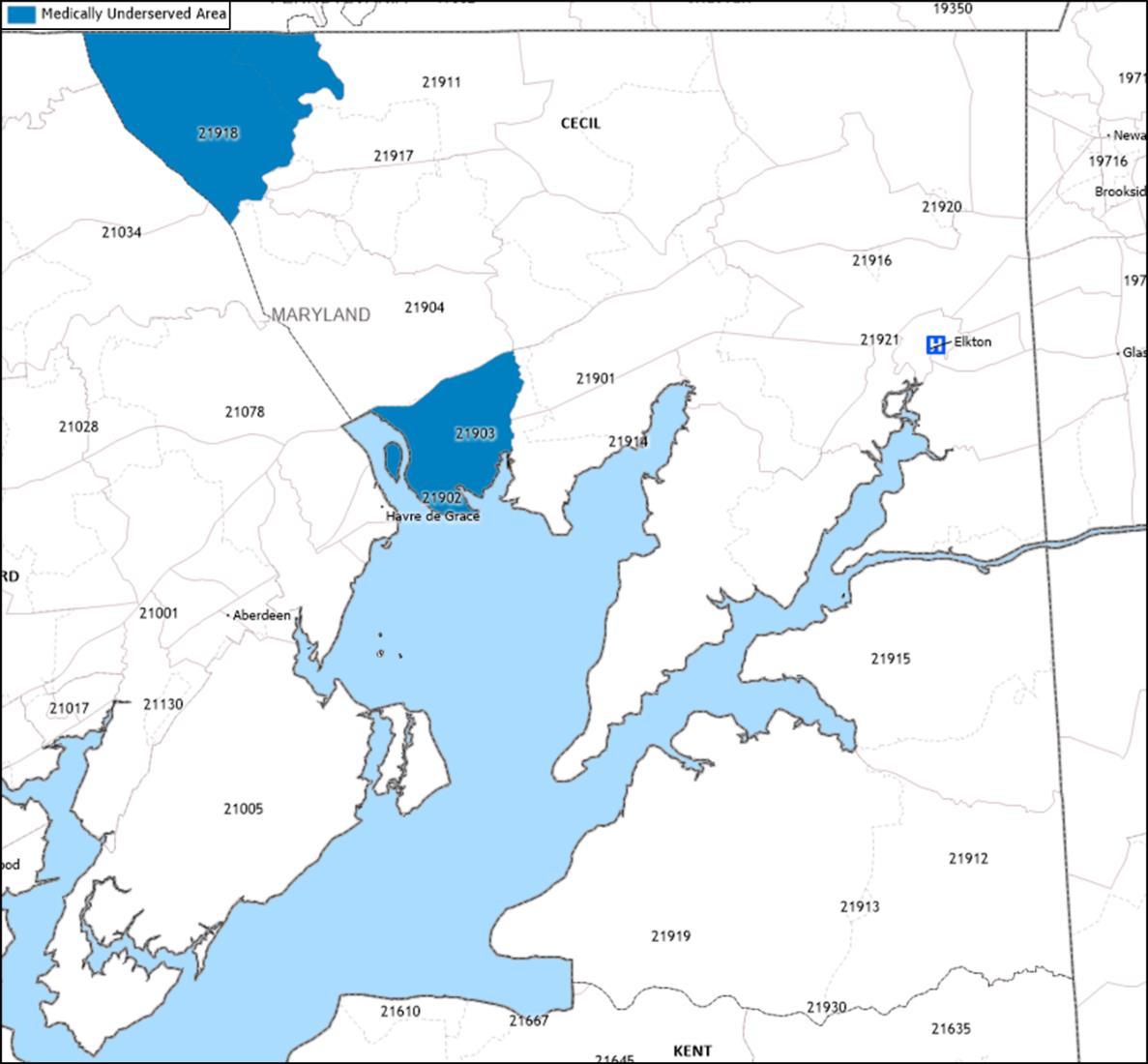
Source: Health Resources and Services Administration, 2025 and Caliper Maptitude, 2024.
Description
Exhibit 51 identifies the location of Medically Underserved Areas (MUAs) and Medically Underserved Populations (MUPs).
Medically Underserved Areas and Populations (MUA/Ps) are designated by HRSA based on an “Index of Medical Underservice.” The index includes the following variables: ratio of primary medical care physicians per 1,000 population, infant mortality rate, percentage of the population with incomes below the poverty level, and percentage of the population age 65 or over.19 Areas with a score of 62 or less are considered “medically underserved.”
Populations receiving MUP designation include groups within a geographic area with economic barriers or cultural and/or linguistic access barriers to receiving primary care. If
19 Heath Resources and Services Administration. See http://www.hrsa.gov/shortage/mua/index.html
a population group does not qualify for MUP status based on the IMU score, Public Law 99-280 allows MUP designation if “unusual local conditions which are a barrier to access to or the availability of personal health services exist and are documented, and if such a designation is recommended by the chief executive officer and local officials of the state where the requested population resides.”20
Observations
• In 2025, census tracts in Conowingo and Perryville were federally designated as Medically Underserved Areas
• There were no federally designated Medically Underserved Populations in Cecil County.
20Ibid.
Health Professional Shortage Areas
Exhibit 52: Health Professional Shortage Areas, 2025
Description
Exhibit 52 identifies the locations of federally designated primary care, mental health and dental health, Health Professional Shortage Areas (HPSAs).
A geographic area can be designated as a HPSA if a shortage of primary medical care, dental care, or mental health care professionals is found to be present. In addition to areas and populations that can be designated as HPSAs, a health care facility can receive federal HPSA designation and an additional Medicare payment if it provides primary medical care services to an area or population group identified as having inadequate access to primary care, dental, or mental health services.
HPSAs can be: “(1) An urban or rural area (which need not conform to the geographic boundaries of a political subdivision and which is a rational area for the delivery of health services); (2) a population group; or (3) a public or nonprofit private medical facility.”21
21 U.S. Health Resources and Services Administration, Bureau of Health Professionals. (n.d.). Health Professional Shortage Area Designation Criteria. Retrieved 2012, from http://bhpr.hrsa.gov/shortage/hpsas/designationcriteria/index.html
Observations
• All of Cecil County has been designated a shortage area for mental health professionals.
• West Cecil Health Center, West Cecil Mobile Medical Outreach Van, and Beacon Health Center were designated HPSAs for primary care, mental health, and dental health.
Findings of Other Assessments
Cecil County Community Health Improvement Plan – 2023-2027
Cecil County’s Community Health Improvement Plan - 2023-2027 is a systematic plan to address health issues identified through the 2022 Cecil County Community Health Needs Assessment (CHNA), to improve the health of our community. The purpose of the plan is to provide a roadmap for how the Cecil County Health Department, partner organizations, and the community will work together to advance the health of Cecil County residents.
Four health issues received strong support from membership; thus, the planning committee decided to include all four in the CHIP, placing Childhood Trauma as a primary area to be addressed under mental health. This resulted in the selection of the following health priorities:
1. Mental Health
a. Childhood Trauma
2. Substance Use Disorders
3. Access to Health Services
Goals for each priority area are outlined below. Please visit Cecil County Community Health Improvement Plan for the 2023-2027 report.
1. Mental Health
1.1. Conduct a health equity assessment to determine where inequities exist related to behavioral health in Cecil County.
1.2. Promote the value of behavioral health wellness and prevention efforts.
1.3. Decrease stigma related to behavioral health disorders.
1.4. Increase awareness of behavioral health needs in the community.
1.5. Increase collaboration among community partners to address the behavioral health needs in the community.
1.6. Educate and empower community members and health professionals on childhood trauma recognition and prevention.
2. Substance Use Disorders
2.1. Conduct a health equity assessment to determine where inequities exist related to behavioral health in Cecil County.
2.2. Promote the value of behavioral health wellness and prevention efforts.
2.3. Decrease stigma related to behavioral health disorders.
2.4. Increase awareness of behavioral health needs in the community.
2.5. Increase collaboration among community partners to address the behavioral health needs in the community.
3. Access to Health Services
3.1. Conduct a health equity assessment to determine where inequities exist related to accessing health services in Cecil County.
3.2. Improve access to behavioral health services to increase the number of individuals receiving services and reduce health disparities.
3.3. Increase access to transportation services for Cecil County residents receiving health services.
3.4. Increase access to cancer screening services in Cecil County.
3.5. Increase access to diabetes prevention and management resources.
Maryland State Health Improvement Plan - 2024
The development of the Maryland State Health Improvement Plan (SHIP) was guided by the State Health Assessment (SHA). The SHA provides a comprehensive report of the state’s current health status and socioeconomic indicators that affect health outcomes. The SHIP establishes priorities, strategies, and targets for improving the community’s health based on the areas of greatest needs identified in the SHA.
The 2024 Maryland SHIP identified five health priority areas:
1. Chronic Disease
1.1. Enhance primary prevention of chronic disease
1.2. Enhance screening, treatment, and care for chronic illness
2. Access to Care
2.1. Enhance care delivery models to meet the needs of different populations
2.2. Recruit and retain high quality healthcare and public health workforce
2.3. Reduce barriers to care
3. Women’s Health
3.1. Improve maternal health outcomes through improved maternal care before, during, and after pregnancy
3.2. Increase breast and cervical cancer prevention, screening, and care
4. Violence
4.1. Reduce firearm-related suicides, homicides, and injuries
4.2. Reduce the rates of, and harms associated, with intimate partner and sexual violence
5. Behavioral Health
5.1. Expand access to, and utilization of, behavioral health services
5.2. Reduce disparities in mental health outcomes
5.3. Reduce overdose and the negative health outcomes associated with substance use
APPENDIX C – COMMUNITY INPUT PARTICIPANTS
Exhibit 53: Community Input Participant Affiliations
Organizations
Amedisys Hospice
CareFirst
Cecil County Government
Cecil County Health Department
Cecil Transit
Deep Roots
Elkton Alliance
Elkton Community Center
Elkton Senior Center
Judy Center
Next Step Physical Therapy
Northeast Library
Paris Foundation
Perryville Library
Union Hospital
Upper Bay Counseling & Support Services ACT Team
Voices of Hope
West Cecil Health Center
Youth Empowerment Source
APPENDIX D – CHSI PEER COUNTIES
County Health Rankings has assembled community health data for all 3,143 counties in the United States. Following a methodology developed by the Centers for Disease Control’s Community Health Status Indicators Project (CHSI), County Health Rankings also publishes lists of “peer counties,” so comparisons with peer counties in other states can be made. Each county in the U.S. is assigned 30 to 35 peer counties based on 19 variables including population size, population growth, population density, household income, unemployment, percent children, percent elderly, and poverty rates Exhibit 54 lists peer counties for Cecil County, Maryland.
Grundy County, Illinois
Jersey County, Illinois
Madison County, Illinois
Dearborn County, Indiana
Harrison County, Indiana
Jasper County, Indiana
Morgan County, Indiana
Newton County, Indiana
Porter County, Indiana
Putnam County, Indiana
Shelby County, Indiana
Union County, Indiana
Bullitt County, Kentucky
Spencer County, Kentucky
Barry County, Michigan
Isanti County, Minnesota
Mille Lacs County, Minnesota
Sibley County, Minnesota
Clinton County, Missouri
Franklin County, Missouri
Jefferson County, Missouri
Lafayette County, Missouri
Wayne County, New York
Clermont County, Ohio
Fairfield County, Ohio
Licking County, Ohio
Madison County, Ohio
Morrow County, Ohio
Pickaway County, Ohio
Cheatham County, Tennessee
Exhibit 54: CHSI Peer Counties
Cecil County
Clinton County, Illinois
Lapeer County, Michigan
APPENDIX E – IMPACT EVALUATION
CHNA Activities
ChristianaCare Union Hospital prioritized the following significant community health needs to be addressed in the 2023-2025 Implementation Strategy:
• Access to Health Services
• Cancer (including smoking, tobacco, and vape product use)
• LGBTQ+ Health Disparities
• Substance Use Disorders
The 2022 CHNA was the first ChristianaCare undertook in Cecil County since acquiring Union Hospital in 2020. We were, and continue to be, grateful for the support and partnership of the Cecil County Health Department to complete that CHNA and in serving our neighbors.
This section summarizes the progress and impact of the activities and initiatives that were implemented to address the prioritized community needs.
Access to Health Service
Cecil County is a small rural community that has a low per-capita supply of primary care, dental health, and mental health professionals compared to national averages. The retirement of even one provider in Cecil County has a significant impact on the community, and more providers are retiring. Like other rural hospitals across the country, Union also experiences challenges recruiting and retaining providers. ChristianaCare is working to address these provider shortages with a diversity of recruitment efforts. While we continue our efforts to hire and retain providers, we are also working to ensure access to health services through programs that address social barriers to access.
In FY2024, Union hired two Acute Care Connectors (ACC) to identify and address patient social needs. Admitted patients are pre-screened for Social Drivers of Health (SDOH) through various admission and assessment documentation. If there are positive findings on the prescreen, the ACCs will complete an in-depth SDOH screening and work to help patients address their needs through community and internal resources. The ACCs are healthcare professionals trained in screening and connecting patients with resources to address social care needs. In FY2024, the ACCs screened 769 patients.
In 2022 Union began to utilize Roundtrip, a company that provides a digital transportation marketplace to connect patients facing transportation barriers with non-emergency medical transportation. We launched Roundtrip for our patients participating in our Care Transformation Initiative (CTI), Chronic Disease Navigation Program. Since then, we have expanded the use of Roundtrip to our primary care practices. In FY2024, 117 Roundtrip rides were provided to 22 patients, a significant increase from the 12 rides provided through Roundtrip in FY2023. While we are pleased that we have been able to provide more transportation through Roundtrip, we know more work needs to be done to make this a truly accessible program. Roundtrip utilizes ride services like Uber and Lyft, and
these are not often available in our rural community. We continue to consider new opportunities and partnerships to effectively address transportation needs in Cecil County.
In FY2023, Union began participating in the Maryland Primary Care Program (MDPCP). Through this program, Union receives funding to address the social needs of Medicare patients. Health Equity Advancement Resource and Transformation (HEART) payments are also used to provide participating patients with hypertension, diabetes, and congestive heart failure with medically tailored foods, self-monitoring equipment, and transportation through Roundtrip to their medical appointments and services. In FY2024, Union enrolled over 100 patients in this program and provided 950 food boxes and 21,000 meals to these patients.
Union’s Childbirth and Early Education team and pediatric nurses are a significant source of childbirth and infant care education in Cecil County. Education is provided both on-site and in the community. Union provides weekly breastfeeding classes, free breastfeeding consultations upon request, and bi-monthly childbirth education sessions. Union caregivers also provide education at the request of community partners like the Cecil County Health Department at different community locations. The Elkton site of the Heritage Pregnancy and Family Health Center closed during FY2024, and so Union’s continued offering of this education at Union, within a mile of the previous Heritage Pregnancy and Family Health Center location, is ensuring a need in the community continues to be addressed. In December 2023, we held our inaugural annual Community Baby Shower at Union. Expectant parents were provided with needed supplies such as diapers and wipes and items like car seats. Connections to community and clinical resources and infant education were also available. 50 individuals were served at Union’s baby shower.
Union continues to provide education on-site at the community treatment provider, Serenity Health, and began to offer education at another treatment provider, Brantwood Family Services, both in Elkton. Those who are pregnant and receiving treatment attend these classes to learn about childbirth and infant care. Attendees also learn about Eat, Sleep, Console, an approach to caring for babies born with Neonatal Abstinence Syndrome (NAS) that can reduce the need for medical intervention
For nearly 20 years, Union has partnered with Cecil County Public Schools to offer a free sports physical event for Cecil County Public School students. Given the provider shortage in Cecil County, this event is significant in ensuring students can receive a physical exam and providing relief to Cecil County practices. At the event, attendees were also provided with information about community resources and helped with enrollment with a primary care provider if they had none. For the past three years, over 500 physical exams have been provided per year at these events.
In FY2024, Union partnered with the Paris Foundation to offer monthly mobile health outreach in Hollingsworth Manor in Elkton. During this monthly outreach, individuals receive blood pressure and vision screenings as well as connections to clinical and community resources.
Finally, for the last several years, we have partnered with Cecil County’s Department of Emergency Services to help design a Mobile Integrated Health program. This program will address repetitive calls for ambulance service by working with the patients to address
their health and social needs. We expect this program to launch imminently, supported by a grant of $75,000 from ChristianaCare.
Cancer
Union has partnered closely with the Cecil County Cancer Task Force to craft and implement public outreach to promote cancer screenings, with a focus on Low Dose Computed Tomography (LDCT), a lung cancer screening, because the mortality rates for lung and bronchus cancer in Cecil County have been considerably above the United States averages
To try and gain a better understanding of the barriers to receiving the LDCT screening, in FY2023 Union caregivers undertook a review of 55 lung cancer patients diagnosed in 2020 and 2021 at Union. Their analysis revealed that only 1 of those patients was referred to LDCT services before diagnosis. Based on this, the team recognized that both patients and providers would benefit from information about LDCT screening. In partnership with the Cecil County Cancer Task Force, a validated survey was sent out to 38 Cecil County providers in October 2022 to gauge their understanding of the LDCT screen and barriers to successful referrals.
Overall, the survey demonstrated provider familiarity with the screen but revealed some opportunities for more education. For example, nearly half of the providers were not sure which patients qualified for the screening. The survey also demonstrated that more patient education is needed. 7 out of the 10 providers surveyed said they were never asked about the LCDT screening by patients and 6 out of the 10 providers surveyed said patients refused the LCDT screening even after it was offered to them.
In response, our caregivers in the Cancer Program have focused on routinely providing education about the LDCT screening to other caregivers during their huddles and other opportunities. We also hired a part-time Lung Health Navigator in mid FY2023. The Navigator helps connect patients directly to screening and helps address barriers to screening. In FY2024, Union performed 537 LDCT screenings, a significant increase from the prior year and a testament to how helpful this service has been in connecting people to screening.
Our caregivers continue to provide cancer prevention and screening education at community events and in partnership with local organizations. For the last several years, we have partnered with Cecil County Public Schools (CCPS) to promote breast cancer screenings for their employees, culminating in a day designated for CCPS mammograms at our Breast Center.
In FY2024, Union also worked to develop a Smoking Cessation Program that will be offered in 2025. As with the creation of the Navigator position, this program was also developed to address a need in the community and improve health.
LGBTQ+ Health Disparities
To begin to address the disparities among the LGBTQ+ population, caregivers may participate in the Pride Ambassadors program, created by ChristianaCare’s Office of Health Equity. The Pride Ambassadors program offers six hours of instruction including
exploration of LGBTQ+ health topics as they relate to creating more equitable healthcare for our LGBTQ+ patients and families. Since the adoption of our prior CHNA, three cohorts of Union caregivers have received this training. We also made the training available to community providers, at no cost. Several Cecil County Health Department employees have since completed the Pride Ambassadors program. Additionally, as a part of the new Nursing Orientation offered bi-weekly at Union, all participants receive an Introduction to LGBTQ+ Health ChristianaCare’s We Ask Because We Care project, implemented systemwide last year, also gives us the organizational capacity to identify, track, and address disparities for this population. Finally, our Community Engagement Manager also serves on a Cecil County Health Department committee which focuses on this population to collaboratively identify and respond to the needs of this population.
Substance Use Disorders
To address substance use disorders (SUD) in Cecil County, Union has long partnered with Cecil County Health Department’s (CCHD) Alcohol & Drug Recovery Center to make available a designated peer recovery specialist for referrals on behalf of Union patients. In FY2024, the support offered to patients through this partnership was greatly expanded with the award of a National Association of County and City Health Officials (NACCHO) grant, Sustaining Peers in the Emergency Department, to CCHD. There are now nine peers, employed by CCHD and Voices of Hope, a community organization, available in the hospital to provide bedside consultations for patients struggling with addiction. The peers provide coverage from 8 a.m. to 1 a.m. every day of the week and serve patients across all medical floors.
By engaging with peers, individuals suffering from substance use disorder will be encouraged to consider treatment and provided with harm reduction strategies. If they want to enter treatment, the peer will support them in meeting that goal. In FY2024, 512 patients were served with 369 of those referred to treatment or recovery support. Of those referred, 144 patients were confirmed to have engaged in behavioral health treatment demonstrating this program’s effectiveness.
As previously described, Union caregivers also provide childbirth and infant education to pregnant women receiving substance use disorder treatment at Serenity Health and Brantwood Family Services in Elkton. A Registered Nurse goes to these community treatment providers to provide educational sessions on topics such as breastfeeding, neonatal abstinence syndrome (NAS), and safe sleep, among others.
On behalf of Union, caregivers also attend Local Overdose Fatality Review Teams (LOFRT) meetings to discuss and case review all unintentional overdose deaths related to street drugs and alcohol in Cecil County. Members are stakeholders from law enforcement, the community, government agencies, and providers. Union’s Program Director for Outpatient Behavioral Health also attends Cecil County Behavioral Health Provider meetings which serve to increase communication, collaboration, and coordination among local behavioral health providers. These meetings are intended to allow providers to learn from one another and ultimately, improve service to the community.
Planning for 2026, and Beyond
ChristianaCare’s mission is to serve our neighbors as respectful, expert, caring partners in their health. We do this by creating innovative, effective, affordable and equitable systems of care that our neighbors value. This CHNA provides us the opportunity to better serve our community and meet our mission. We cannot effectively partner with our neighbors if we do not understand the challenges and needs of our community.
We will consider this assessment and the successes of our existing programs to address community needs, as well as areas for improvement, to determine how best to continue and advance our efforts to improve the health of our neighbors.
